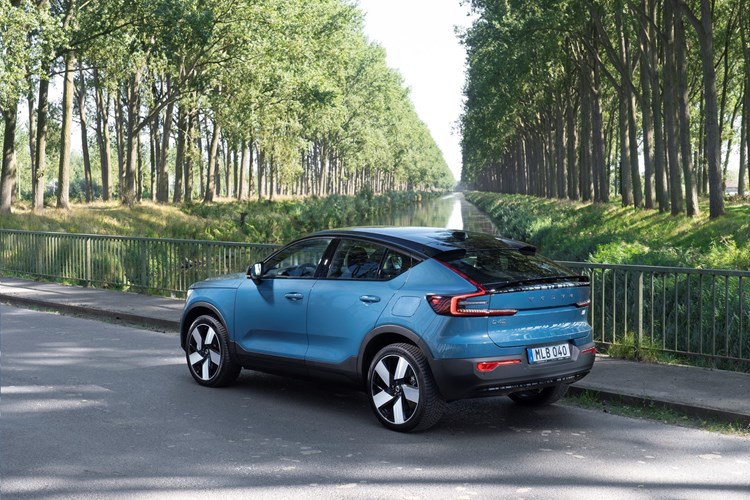Volvo
-
2020 Volvo XC70
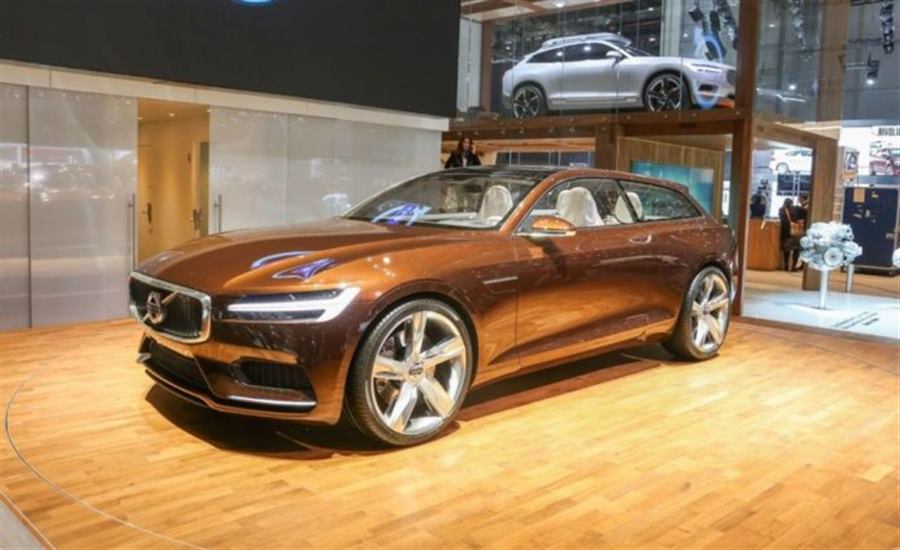
The company from Sweden plans to expand its range of car models. The 2020 Volvo XC70 will be a positioned between the XC60 and XC90. According to information, it will move to a medium size segment, luxury and comfort. Top safety scores and continual updates to safety features put the Volvo Xc70 among the safest cars in its class.
2020 Volvo XC70 Engine
The compact XC60 and XC90 medium sizes use the T5 and T6 engines, and there is no reason to exclude the Xc70 from the power of one or both models. The basic T5 is a four-cylinder four-cylinder 2.0-liter unit. It generates 250 hp and 260 Ib-ft of torque. It has a standard front-wheel drive, while the four-wheel drive is optional. The automatic gearbox with eight speeds is a power router, while there is also a fuel saving plug in the form of a Start / Stop function. The T6 is a powerful car that delivers 316 hp and 295 Ib-ft of torque at the exit. 2020 Volvo XC70 will only be available with AVD. The T5 and T6 are very capable of driving, and the new 2020 Volvo XC70 can count on a £ 5,000 pound capacity. It will offer its customers a plug-in hybrid T8 engine, which can break 400 hp and 470 pounds per minute. The fuel economy is increased to 25 mpg or 60 MPGe. The PHEV model can only be powered by electric power, so be sure that the new 2020 Volvo XC70 comes much better than its predecessor.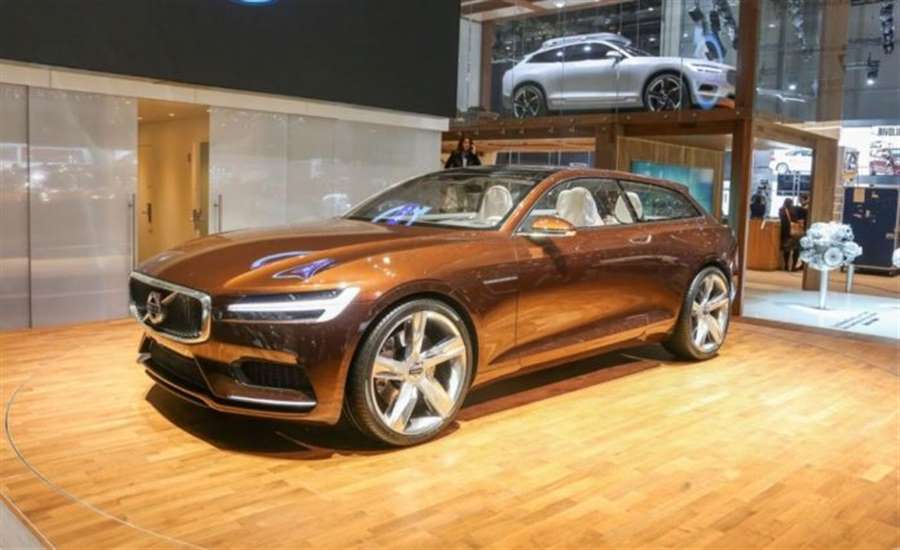
The new look of XC70
The company is one of the leaders in electrification, so it would not be surprising that the new XC70 will come up with an electric battery that will be able to get up to 500 miles and headlamps up to 400 miles.2020 Volvo XC70 Interior
The company works to increase quality, and the new model Xc70 will have Auto Drive features of Level 3. This self-driving system gives drivers the ability to do something else while driving while safely reaching their destination. Also, there will be a function of maintaining the lane with automatic braking and steering, as well as a great parking system. We expect a full leather upholstery, a large screen for information and entertainment that will be located in the center of the dashboard. There will be elements and elements from your Ambience Interior concept. The combination of visual and sound as well as scented effects, but the easy access from a phone or sound application allows you to choose the ambience according to your mood.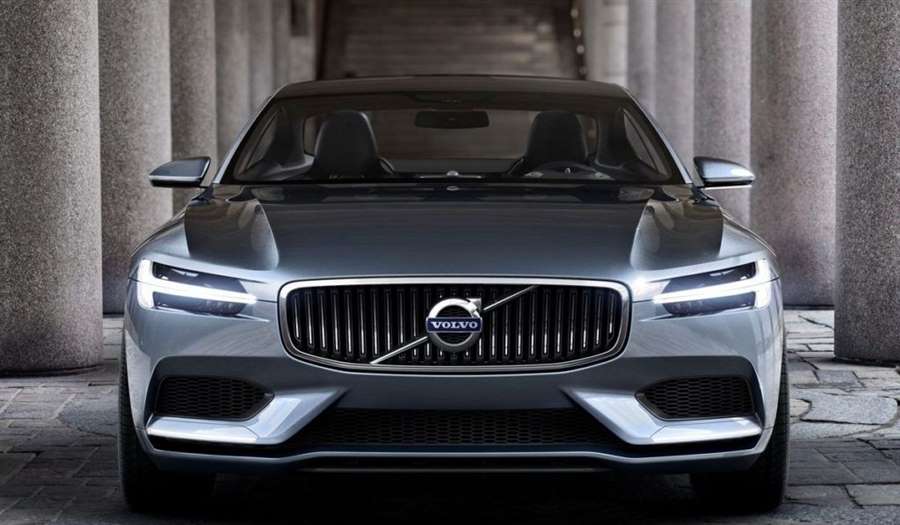
2020 Volvo XC70 Price
The price on new Xc70 will not be below $ 80,000. Of course, the price will grow if you add certain details like the Ambience interior system. In case you decide to drive for conventional drives, the cost will be between $ 40,000 and $ 50,000, while the Plug-in hybrid T8 engine will be available for about $ 65,000. -
2021 Volvo XC60 Recharge Review: Plug-In Hybrid Pass/Fail
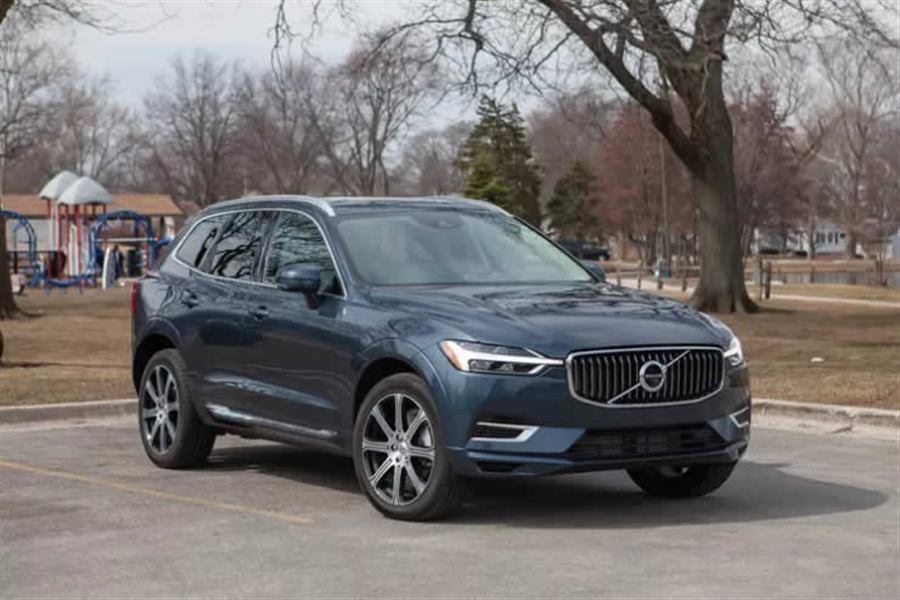
The verdict: Volvo’s five years of experience building plug-in-hybrid SUVs seems to be paying off, as the Recharge T8 version of the 2021 XC60 luxury compact SUV is as well rounded in its plug-in aspects as the gas version is in every other way.
Versus the competition: This will soon change, but the XC60 T8 has few direct competitors, though it matches the 2021 Audi Q5 e for electric range and gas mileage, and it trounces the 2021 BMW X3 xDrive30e in the latter category. For both metrics, the model to beat might be the Corsair Grand Touring, coming this spring from a resurgent Lincoln.
Volvo appears to be using the word “Recharge” to represent any vehicle with a plug, be it a pure battery-electric, such as the new XC40 Recharge subcompact SUV, or this plug-in hybrid version of the XC60 compact SUV. Perhaps a better indicator is the “T8” powertrain designation, which we’ve seen only on plug-in hybrids, including the larger XC90 Recharge T8. The original Volvo XC60 is an excellent luxury compact SUV, good enough to win our 2018 comparison test. Not much has changed — either for the XC60 or its competitors — since. Rather than rehash what we like about it, I’ll direct you to our most recent comprehensive review of the regular XC60 and focus here on the plug-in hybrid.
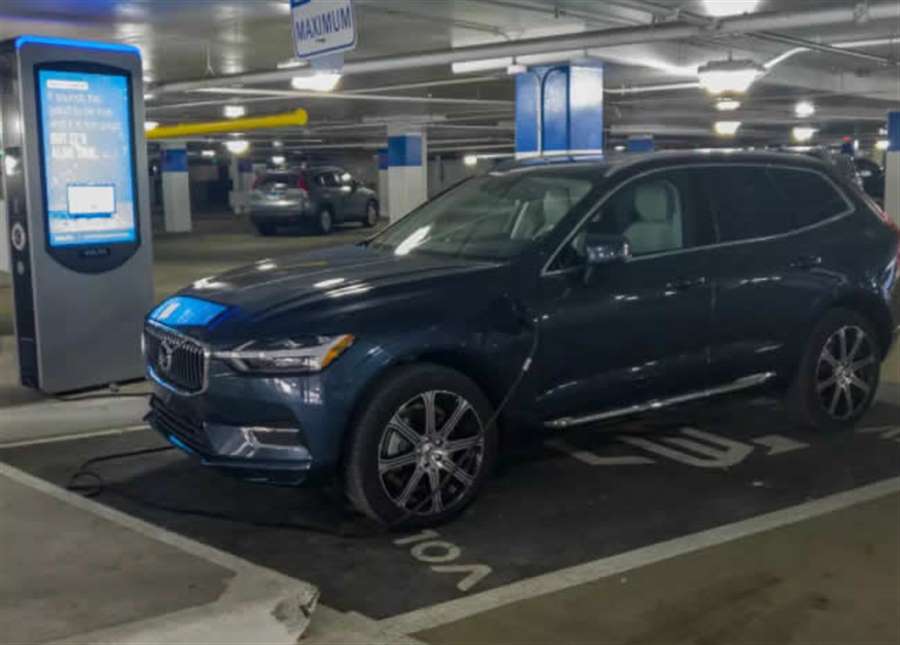
Ten years’ experience has revealed the many ways in which a plug-in hybrid electric vehicle, or PHEV, can go astray, so I’ve come to focus my evaluations of them on these factors. Each area undergoes a pass/fail test to determine whether the vehicle as a whole passes muster. Behold the XC60’s Recharge’s results:
Electric Range
This is an important one because early PHEVs had electric ranges that were comically short. One of the first, the 2012 Toyota Prius Plug-In Hybrid, could drive only 6 miles on electric power, as estimated by the EPA.We’ve come a long way since then. Most PHEVs go roughly 20 miles before their gas engines are needed, and they can even achieve highway speeds gas-free. The Prius Plug-In’s successor has been succeeded by today’s vastly improved Prius Prime, which has a 25-mile electric range. The EPA estimates the XC60 T8 can go 18 miles on a charge. I matched or exceeded that number twice, thanks in part to favorable weather.
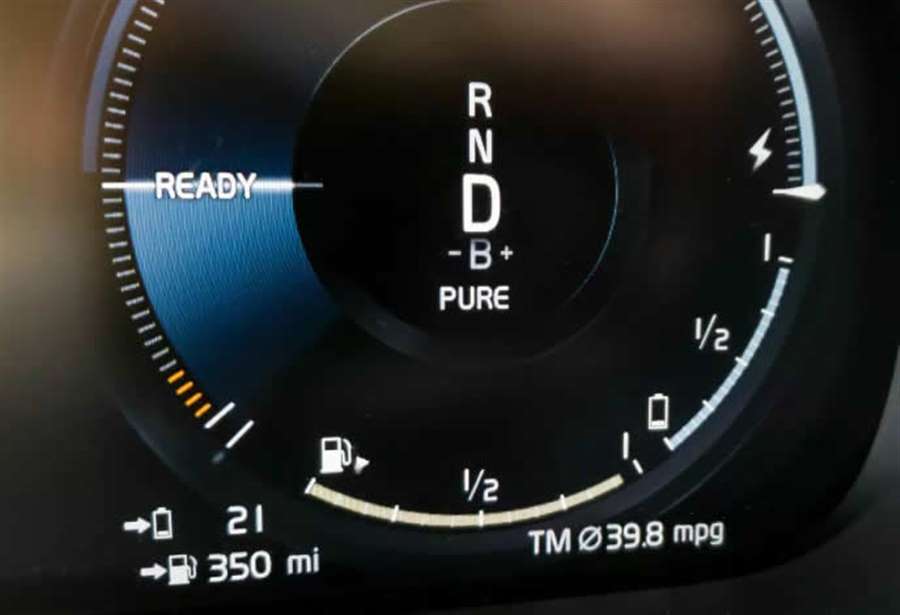
This test isn’t about whether the vehicle hits its estimate, though; it’s about the range itself, and anything under 20 miles feels too short. I know 18 miles is technically long enough — and I underscore that a 20-mile trip that uses gasoline for only 2 miles is still great — but the key word here is feels. American shoppers are driven by feeling as much as logic, if not more. (By the same token, 150 miles doesn’t feel like enough range for an all-electric car, even though it’s usually more than enough if you charge it nightly at home.) Also, cold temperatures invariably shorten range. So, bearing in mind that each of these pass/fail tests add up to an overall verdict, I’m going to consider any PHEV range under 20 a failure (or just a fail, as the kids say).
Pass/fail verdict: Fail
Electric Acceleration
In a plug-in hybrid, you want to have enough power to drive in electric-only mode without triggering the gas engine, at least under normal conditions. This is mainly a psychological thing given that it doesn’t hurt if the engine runs for a minute or two. It’s just the principle of it, you know? In its default, hybrid driving mode, the XC60 Recharge will accelerate under electric power at lower speeds, and you can maintain that so long as you keep the virtual needle on the gauge from crossing from the lightning symbol side of the tick mark (electric) to the droplet symbol side (gasoline). Note that while the needle moves with your acceleration, the tick mark and the threshold between electric and gas are also a moving target, depending on load, incline, etc.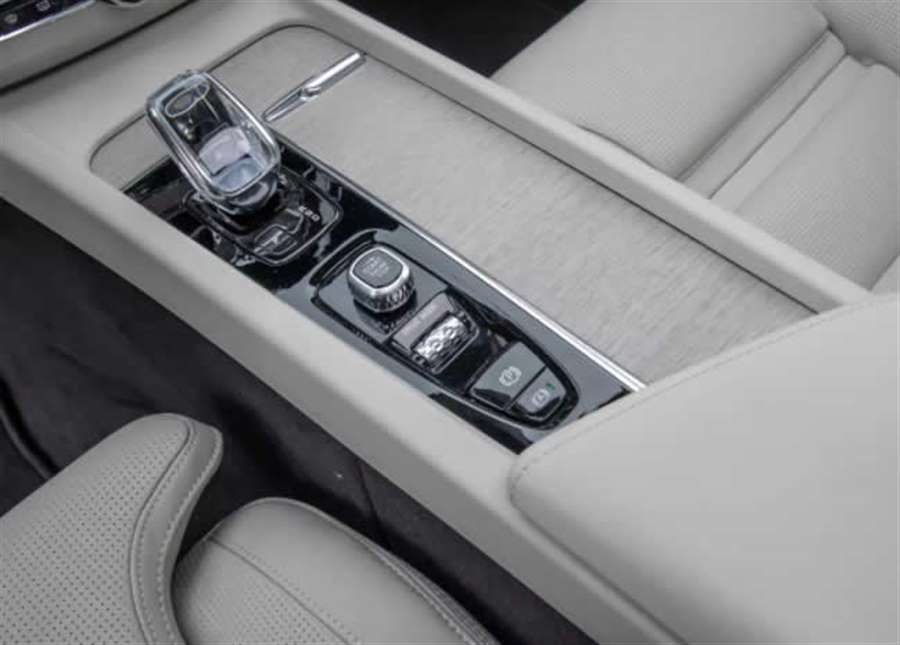
The true test of electric acceleration comes by locking a car in electric propulsion, which you do in the XC60 T8 by selecting the Pure driving mode; it’s available so long as there’s enough juice in your battery pack. In Pure mode, you can accelerate as hard as you want and stay in electric mode — so long as you don’t click the switch at the bottom of the accelerator pedal’s travel (it used to be called the kickdown switch). Power in the Volvo is modest because the goal in a PHEV isn’t to have a super-powerful electric motor and a super-powerful gas engine; that would be inefficient. The goal is for the motor and engine to be powerful together. If you’re in a bind and you floor it and click that switch, the gas engine comes to life and you get full acceleration. In normal driving, I found the Volvo’s electric mode to be adequate 95% of the time — but it bears noting that Cars.com is headquartered in the flatlands of Chicago.
I was able to achieve 70-plus mph on the highway, but one time after merging onto an interstate, I encountered a gentle uphill slope that climbed for at least a mile. With the T8 powertrain at the height of its electric abilities, I was below the speed limit and barely tacking on mph — with drivers behind me getting irritated and whipping around me. This was with only me in the car and no cargo weighing it down. Of course, in this instance, I could have easily floored the pedal the rest of the way and used the gas engine. If ever I had to pass, I’d definitely have needed to. If you drive in a hilly region, I suspect you’ll rely on the XC60’s gas engine more often than I did.
In my electric acceleration test, the XC60 T8 was borderline. It was certainly less effective on highways and hills, but because I like how it’s executed and it worked well where I drove it, I’ll give it a pass.
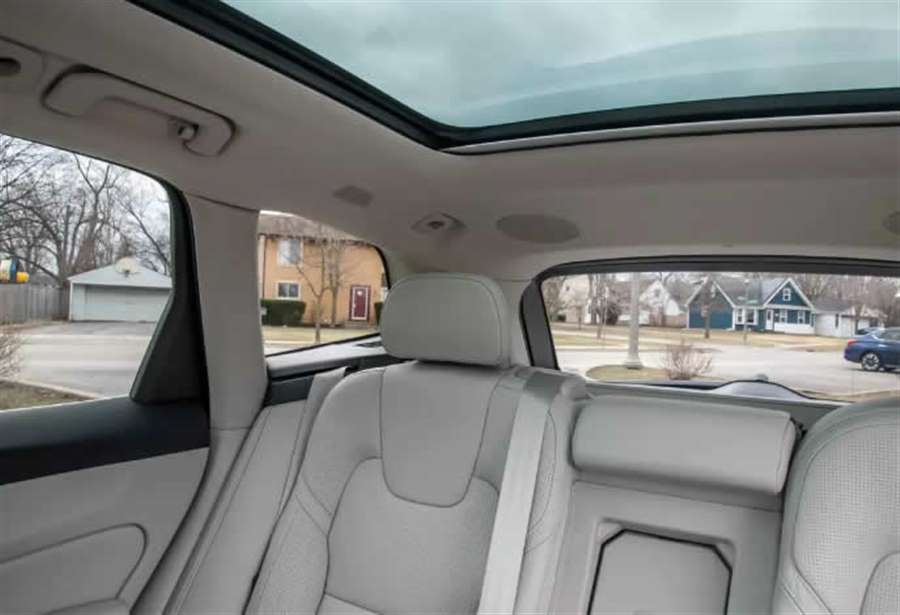
Pass/fail verdict: Pass
Hybrid Acceleration
Hybrid acceleration is also important, and it has different aspects. First, you don’t want to make sacrifices, and Volvo seems to know that. Its combination of the supercharged and turbocharged 2.0-liter four-cylinder engine with an electric motor provides 400 total system horsepower (415 hp in the Polestar Engineered trim level, thanks to different gas-engine tuning). These numbers are well above the most powerful non-hybrid XC60 — the T6’s 316 hp — but the hybrids also weigh considerably more, so it’s best to look at 0-60-mph times. According to Volvo, the T8 powertrain is the quickest to make that run, at 5.0 seconds (4.9 seconds in the Polestar Engineered). The T6 is rated at 5.6 seconds and the all-wheel-drive T5 at 6.4 seconds, so not only are you not losing acceleration by choosing the PHEV, you’re gaining it.Then there’s how the acceleration feels. Hybrid powertrains have traditionally felt kinda herky-jerky, and that would definitely be a sacrifice in a luxury vehicle. Volvo has done a nice job with this one. It incorporates the same eight-speed automatic transmission as the non-hybrid T5 and T6, so you don’t get the droning and rubber-band effect earlier hybrid adopters suffered. It doesn’t feel 100% conventional, but it’s pretty close. The XC60 T8 passes the hybrid acceleration test.
Pass/fail verdict: Pass
Braking
That brings us to braking. Hybrid braking is often nonlinear and mushy-feeling — just generally not what you want. We’ve put up with it for the sake of better mileage, though, and fortunately hybrid braking action has been improving. Again, Volvo’s done a nice job here. I didn’t mistake the XC60 T8’s pedal feel for a conventional braking system, but some people might. It passes.Pass/fail verdict: Pass
The Interior
If you don’t think the interior matters, you’ve probably never inspected a plug-in hybrid version of an existing vehicle before. Historically, squeezing a second propulsion system into a vehicle that wasn’t designed for it has meant something had to give. Battery packs in particular tended to diminish interior space, robbing either backseat legroom or cargo volume.The XC60 T8 passes the cabin test with flying colors. Its seating dimensions are exactly the same as the gas-only versions of the XC60 front and rear.
Pass/fail verdict: Pass
Cargo Space
While we’ve seen some PHEVs whose floors are elevated to accommodate a battery pack, that’s not exactly the case here — though there is something weird going on because it isn’t perfectly level, which I don’t recall from the non-hybrid. It’s barely noticeable, though, and the cargo dimensions are once again the same between the regular and the Recharge versions of the XC60. The main sacrifice — visible if you raise the floor — is the lack of a spare tire. Instead, you get a compressor and some sealant goo. Honestly, there are a lot of vehicles nowadays that lack a spare tire with less of an excuse than the XC60 Recharge, so I’m not going to hold this against it.Pass/fail verdict: Pass
Towing Capacity
Some hybrids just can’t hack towing, but the Recharge is rated to tow 3,500 pounds just like other XC60s. You can get an SUV that tows a considerably heavier trailer than the XC60, but when it comes to PHEV versus gas-only, the Recharge T8 passes the towing test.Pass/fail verdict: Pass
Gas Mileage
Gas mileage is a crucial consideration, even if the vehicle has a long electric range but especially if it doesn’t. For the Volvo, there’s good news here: Once its electric charge is depleted, the XC60 Recharge is rated 26/28/27 mpg city/highway/combined on required premium gas. The XC60 T6 that’s closest to the Recharge’s performance is rated 23 mpg combined. Even the most efficient XC60 T5 with FWD is rated 25 mpg combined — 2 mpg less than the T8. That means you could buy a Recharge and never plug it in and you’d still get better mileage. While that would be a pointless waste, and I hesitate to give anyone bad ideas, any PHEV with better combined mpg than the rest of its range even without plugging in gets an automatic pass in the gas mileage test.Pass/fail verdict: Pass
Overall Range
Another test inspired by PHEV history, this one is necessary because, while it’s pretty easy to see good electric range figures and mpg ratings, overall range is easily overlooked. When an automaker shrinks the gas tank significantly in order to make room for batteries, for example, the overall range can end up being pathetic. Not to fear: According to EPA estimates, the XC60 T8’s total range is 520 miles, 502 on gasoline. This beats the T5 FWD by 32-50 miles. The T8 passes the overall range test.Pass/fail verdict: Pass
Price
The price test takes into account all the other tests. If a vehicle fails many of the previous tests, any price premium would be harder to swallow — and, conversely, if a vehicle had leading electric range or some other stand-out attribute, a higher price could be justified.Because there’s a federal tax credit of over $5,400 for the Recharge, its price ends up being roughly $500 more than a comparable trim level with the T6 powertrain — the most powerful non-hybrid XC60. You can pay several thousand dollars less for a T5, but, as we’ve covered, it will be both less powerful and less efficient. Some $500 seems a small price to pay for a plug-in hybrid of the XC60 T8’s capabilities. At least so long as the tax credit remains available, it passes this test, as well.
The downside to tax credits is you have to pay more up front and won’t get the money back until the IRS sends your tax returns the following calendar year. The XC60 Recharge T8 starts with the Inscription Expression trim level with standard all-wheel drive at $54,595 (all prices exclude the incentive but include destination charges). It also comes in R-Design and Inscription trims before topping out with the Polestar at $70,595. Our test vehicle was an XC60 Recharge T8 Inscription with a base price of $61,000 but a total sticker of $71,340, including many options such as the Climate Package, Advanced Package, 4-Corner Air Suspension, Bowers & Wilkins premium audio and more.
Pass/fail verdict: Pass
Final Test Results
It shouldn’t surprise you that the 2021 Volvo XC60 Recharge T8 passes the overall plug-in hybrid test with flying colors. Honestly, I’d happily trade some of its horsepower and acceleration for more electric range, but it isn’t that simple when you’re combining electric motors with gasoline engines in existing models; automakers typically work with platforms that weren’t designed for hybrid use (though this is slowly changing), and they only have so many engines of their own to choose from. Given how many challenges and trade-offs manufacturers face, and the results we’ve seen in other PHEVs, Volvo has balanced things out quite nicely here. Five years of experience building plug-in hybrid SUVs is evident in the 2021 XC60 Recharge T8. -
2021 Volvo XC90 T8 Tailored Wool Interior Review: Wooly Bully
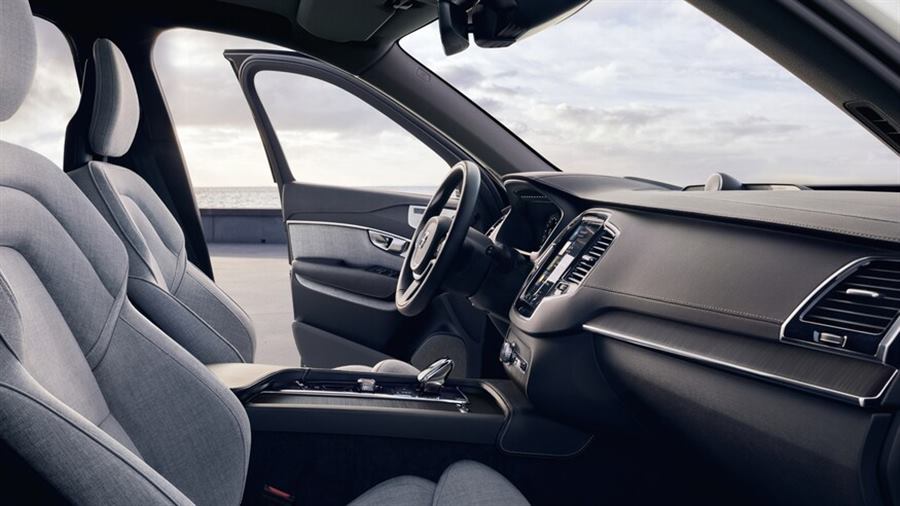
Warmer in winter and always cooler than ubiquitous leather.
Why does everybody want a leather interior? These days even cars that aren't lined with cow mostly get swathed in petrochemicals longing to pass for cow, with euphemistic marketing handles ranging from the generic leatherette or vegan leather to trademarked monikers like BMW's SensaTec, Mercedes' MB-Tex, and VW's V-Tex. Some of our favorite car interiors ever have sported cloth seats, from the Porsche 928's psychedelic Pasha checkerboard to the 911's Pepita houndstooth and various tartan plaids. Sadly, they're all but gone today. So it seemed downright newsworthy when a 2021 Volvo XC90 T8 turned up in my driveway swathed in wool upholstery fabric. Volvo calls it Tailored Wool Blend, and I relished every cosseted moment in these thrones.
What Is Tailored Wool Blend And What Colors Are Available?
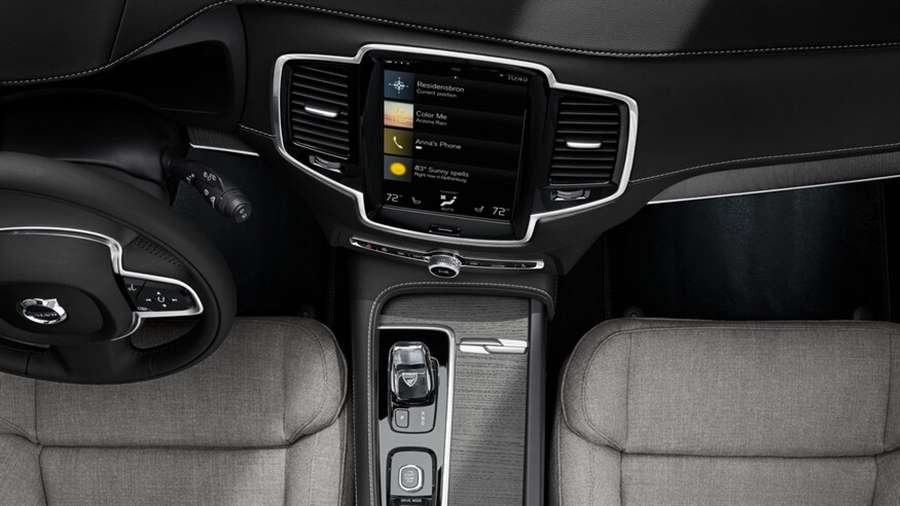
This tweedy weave is comprised of 30 percent wool and 70 percent recycled polyester, so it might be even earth-friendlier than "vegan leather." Tailored Wool Blend appeared as a no-cost option on the 2020 refresh of the XC90 Inscription model in a color called Midnight Zinc. The same option is also available on XC60 Inscription models.
At launch last year, a second color called Slate was offered, but it proved less popular and was dropped for 2021. Volvo does offer another textile, known as City Weave Textile fabric, as a no-cost option on the S60, V60, and XC60 Momentum trim grades. It's in a hue called Blonde and paired with Iron Ore Inlays, and it appears darker and more "plaid" than our Midnight Zinc material.
Inherent Climate Comfort
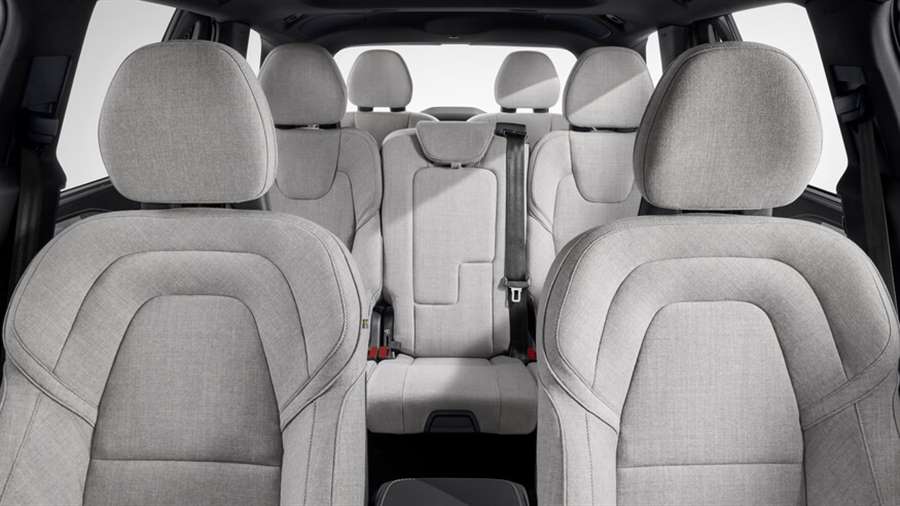
It should surprise nobody that cloth seats always feel warmer in the winter and cooler in the summer—even when contacting bare skin after direct sunlight exposure. The material also presents less resistance to heating, so you'll generally tend to feel the warmth from seat heaters faster. Despite their inherently breathable nature, Volvo at least does not offer a ventilation/seat-cooling option with either its Tailored Wool Blend or City Weave Textile upholstered seating.
What About Cleanup, Care, And Maintenance?
First, how big a slob are you? Inveterate drive-thru diners who regularly juggle sloppy Big Macs while driving will probably find that leather/pleather/vinyl products wipe clean easier. Long-haul car owners who read their owner's manuals and attempt to adhere to the recommendations therein will find that greater care and maintenance is recommended for leather. Case in point: The manual in our XC90 T8 devoted just 84 words to describing how to clean the wool blend but prattled on with 267 words of advice for maintaining the leather, including a recommendation to apply protective cream quarterly. I can tell you this much: Volvo deems Tailored Wool Blend kid-friendly enough to offer its $300 integrated center booster cushion. I'd cheerfully order up a textile interior and just apply some Scotchgard from time to time.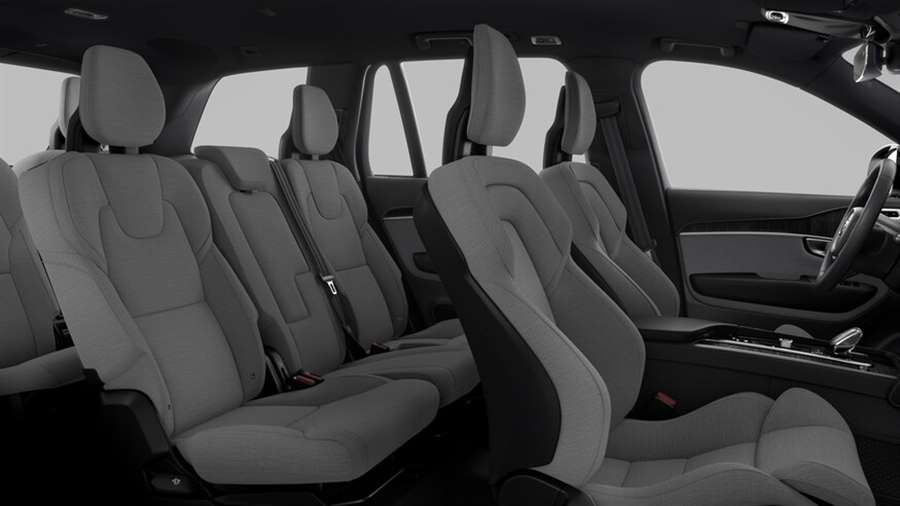
Might The Fad Be Returning?
Way back in the era of chauffeur-driven "town cars" featuring an enclosed passenger compartment and an exposed front seat, Jeeves sat on durable, weather-resistant leather, while His and Her Grace luxuriated in mohair, wool, or other sumptuous fabrics. Velvets and other fabrics remained popular in luxury cars well into the '60s, and wool remains the fabric of choice for "Toyota's Rolls-Royce"—the Century—because it's deemed more dignified; fidget as you will, a wool seat will never make the flatulent noises leather can. Bentley has just reintroduced a Mulliner Tweed interior, using fabric sourced from Scotland, though it's generally used to adorn the door panels. (Of course, companies like Bentley and Rolls-Royce will cheerfully swaddle any part of their cars in any material you desire if the price is right.) We must point out that one of our favorite cloth upholstery offerings of all time remains available on the 2021 Volkswagen GTI: Clark Plaid cloth inserts. Come on, Tesla, why not double down on your new Plaid powertrain by offering a nice tartan upholstery package?
-
2022 Volvo XC60 Recharge T8 Extended Range Gets More Everything
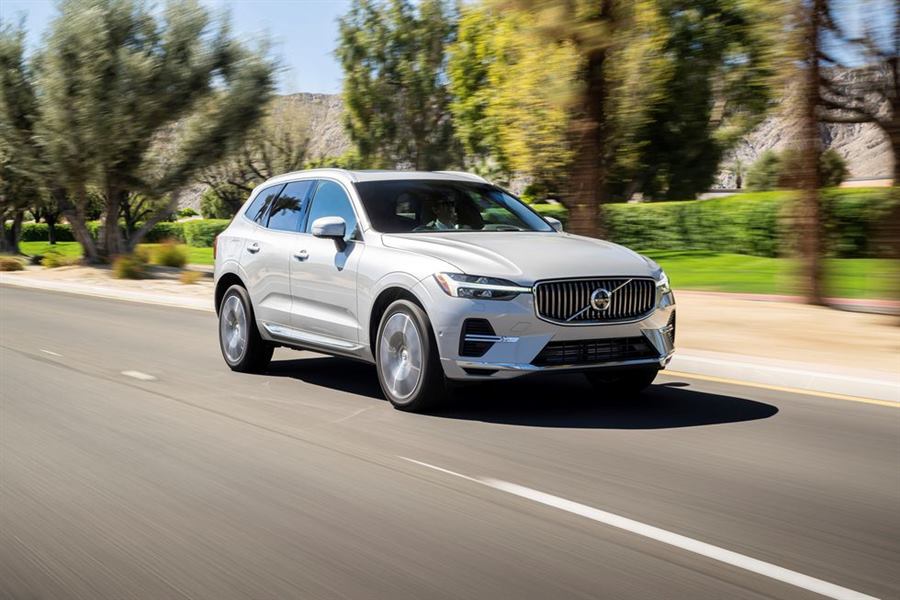
Added batteries, a tweaked turbo four, and a more potent electric motor deliver more power while doubling all-electric capability and lowering emissions.
One of the distinct advantages of the auto industry's current moment of record profitability is the ability it gives carmakers to invest in truly worthwhile upgrades during mid-cycle refreshes. Witness Volvo's plug-in hybrids, specifically the latest version of the XC60 Recharge T8 Extended Range. Like its XC90 big brother and the company's refreshed S60, V60, and S90 hybrids, it sports a new-for-'22 powertrain that extracts more power from its electric motor, revised to loft its lusty (and also freshly tweaked) supercharged and turbocharged 2.0-liter four-cylinder to new heights, with additional battery cells delivering greater all-electric range.
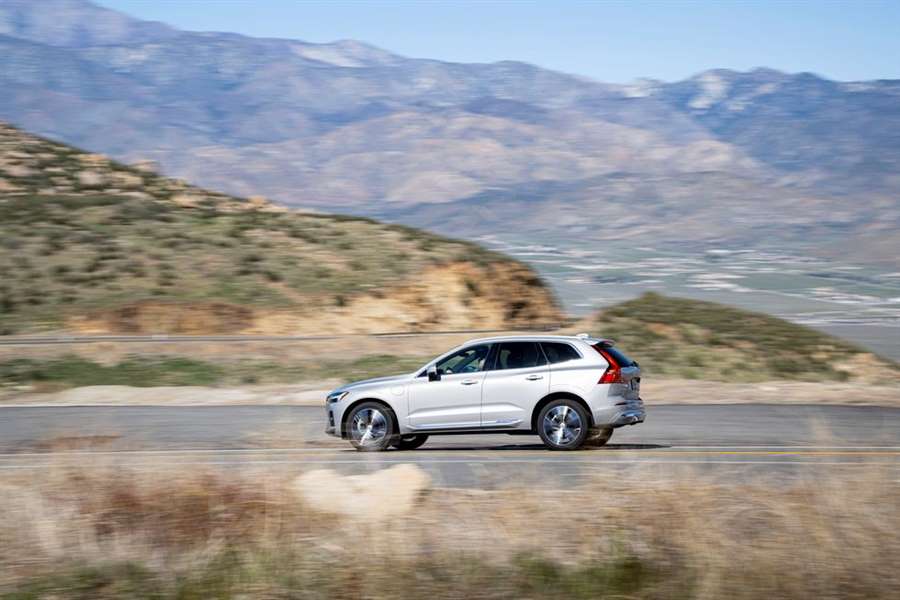
Thanks to a new, third layer of cells, the T8 battery pack's capacity jumps from 9.1 kWh to 14.9, increasing its range in all-electric operation—what Volvo calls "Pure" mode—to 36 miles, up from 19, a not insignificant improvement. Volvo research suggests that customers spend fully half their time in all-electric mode. For those with charging capability at home or at work, Volvo proposes, most daily driving can be tackled in the new model on electric power alone. As a further benefit, buyers qualify for the federal government's full $7500 tax credit, as against the $5419 available for buyers of its predecessors with their skimpier range.
Revisions to the powertrain see its output skyrocket 55 horsepower to a whopping 455 total horsepower, with the upgraded electric motor chipping in 143 of those to go along with the 313 ponies that come courtesy of the tweaked gasoline mill. Up substantially from the outgoing model's 87 horsepower, electric motive force gets directed to the rear wheels, while the gas engine takes care of the fronts. With this much horsepower and a Brobdingnagian 523 pound-feet of torque, the refreshed mid-size SUV stands with its aforementioned brethren as the most powerful cars Volvo has ever brought to market. Such is the promise and pleasure of electrification.
With an EPA-estimated 63 MPGe, the economy potential is infeasibly high. In a random sampling of roads at a launch event in and around Palm Springs, California, helpless to resist the siren call of its massive power, we still managed to eke out a still creditable indicated average of 45 MPGe.
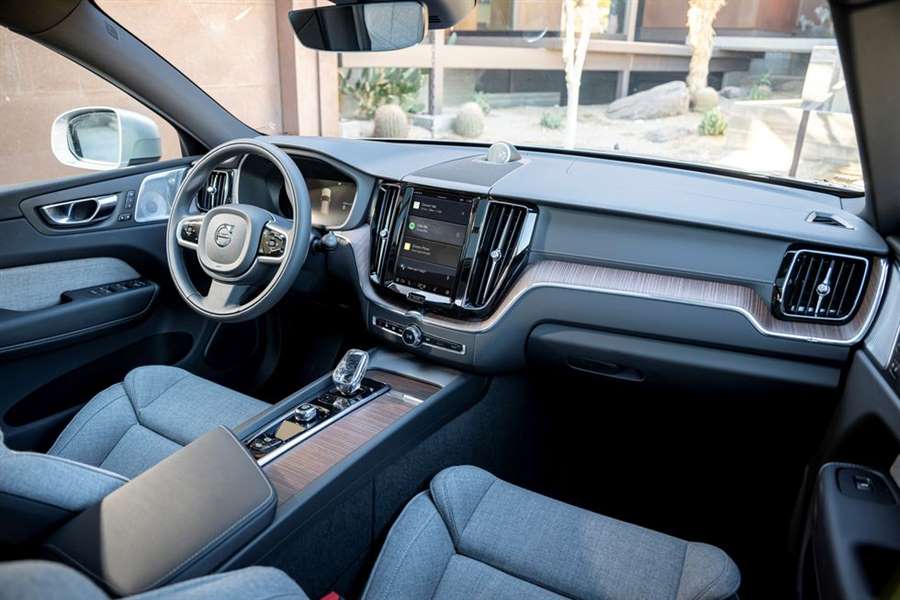
Volvo cites a 4.5-second 60-mph sprint for the Recharge T8 Extended Range (shaving half a second off the old model's best effort), and performance with both powerplants firing is predictably sparkling. As well it ought to be with that much torque to call on, even allowing for the XC60 hybrid's borderline portly claimed 4758-pound curb weight. But despite the extra juice, the power glut is not obtrusive as the vehicle's two diverse and generally harmonious powertrains got down to it, save a one-time, mild clunk from the rear. In Pure electric mode, pickup remained acceptably brisk but not neck-snapping.
One-pedal driving—where regenerative braking causes the car to slow when the driver lifts off the accelerator without applying the brakes—is a new and much appreciated feature for the hybrid model, one that was previously seen only on the firm's EV offerings. Those who've not experienced it will quickly get the hang of one-pedal operation and, in our experience, quickly grow to enjoy it, slowing down with a counterintuitive smoothness that quickly becomes second nature. Use of the feature is selected by double-clicking the gearshift into Drive after selecting the Pure driving mode on the central screen. It proved unexpectedly addictive while charging up this sure-footed chassis, then rapidly descending, winding mountain roads.
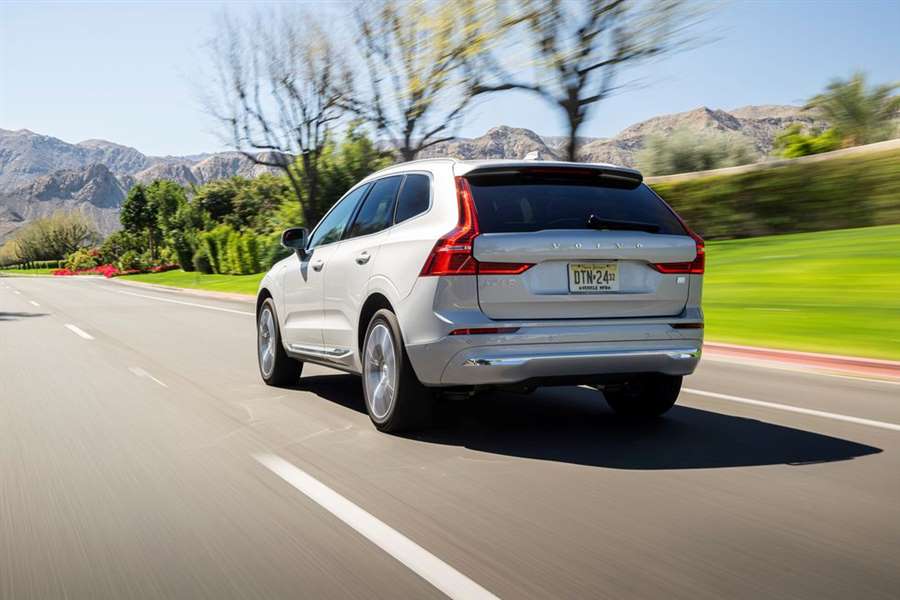
External updates are subtle for this refreshed and still quite handsome model, with a new grille and rear bumper its most noticeable external changes. Prices start at $55,845, so the XC60 Recharge T8 Extended Range is not cheap, though, in an era of rising car prices, surely reasonable. Nor is it as expensive as it feels, with quality fittings and distinctly good looks that amount to extraordinary style in an era where cheap plastics dominate and, with few exceptions, SUVs tend to toggle between ugly and boring. This XC60 Recharge is neither, and its revised, ultra-modern dash and uniquely stylish interior design help make it legitimate competition for models costing far more. Particularly appealing was our sample's fabric seating, a wool blend (available only in gray) that promises to be comfortable in extreme weather both hot and cold.
All in all, the XC60 Recharge T8 Extended Range provides proof that in car manufacture as in life, having the money to up one's game is preferable to not.
Source: https://www.caranddriver.com/reviews/a39475986/2022-volvo-xc60-t8-recharge-drive/
-
Factories are closing, sales are falling: Volvo is in big trouble
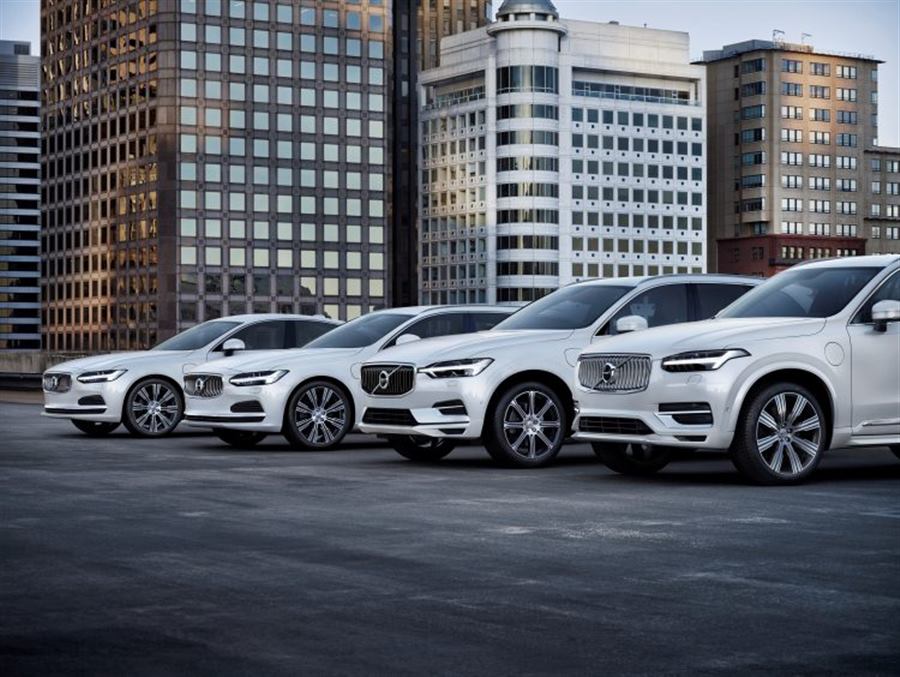
During the previous two years, Volvo was one of the few car manufacturers that, despite all the difficulties, recorded an increase in sales, but now they too have found themselves in a problem.
During August, the Swedish company delivered 43,666 vehicles to customers, a decrease of 4.6 percent compared to the same period last year. According to the official announcement, the reason for lower sales is the lack of microchips.
Although demand remained high, the Swedish company simply could not meet it due to disrupted supply chains and component shortages. However, in the meantime, another big problem has appeared for Volvo, and that is the increase in the number of people infected with the coronavirus in China. The Swedish company announced on Thursday that it was temporarily closing its plant in the city of Chengdu due to local restrictions on movement, and another Volvo plant in China has recently been affected by increasing shutdowns imposed by Chinese authorities to reduce the number of infections.
The factory in the Chinese city of Chengdu is very important for Volvo because their best-selling model – the XC60 – is produced there, and it is not yet known when this plant will be closed. In terms of sales, after the XC60, Volvo customers most often chose the XC40 and XC90 during August.
-
The new electric Volvo and the announcement of the end for petrol and diesel
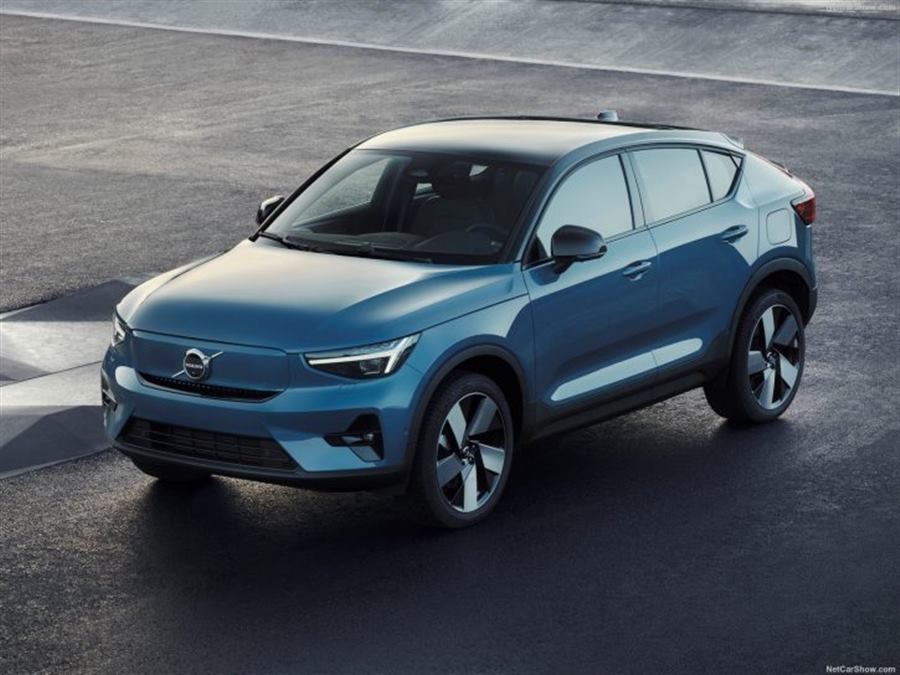
After Jaguar Land Rover, Bentley, GM, Ford and others, Volvo has now announced that from 2030 it will produce exclusively electric cars. That's why they accelerated a bit, so today the second electric model of the company was shown - C40 Recharge.
Moreover, the Swedish brand plans that from 2025, half of the sold Volvo cars will be powered by electricity, and the other half by hybrid drive.
This means that in just four years, they will stop selling models powered exclusively by SUS petrol or diesel engines. And whoever decides to buy a new Volvo in ten years, the only models that will be available will be electric.
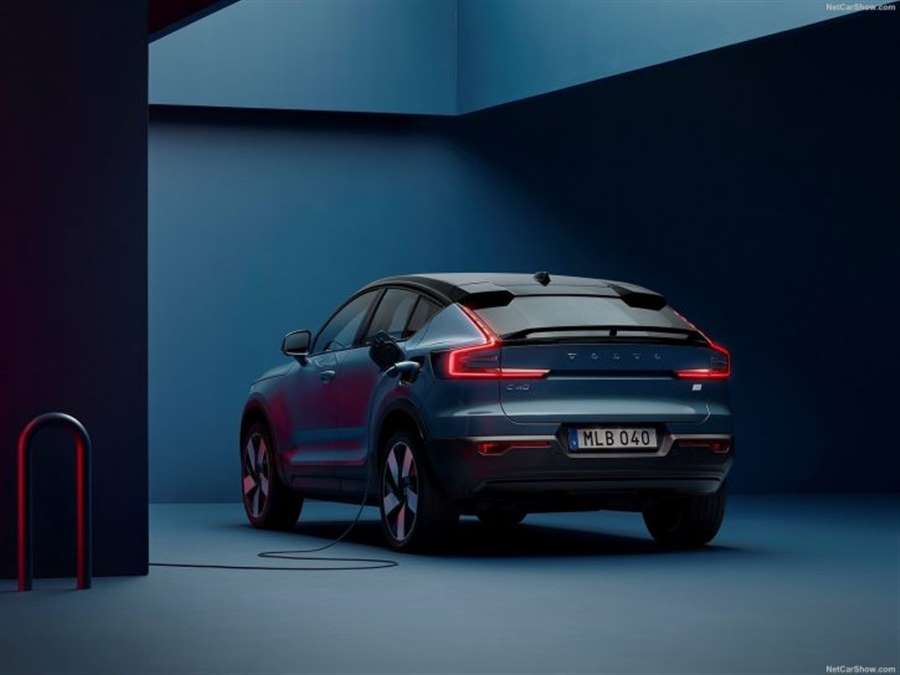
Volvo is owned by the Chinese company Geely, from which it has been confirmed that the conventionally powered models will be on sale only for a while longer, all in order to meet the stricter standards on harmful gas emissions, writes CNN.
It will be a very difficult task for a company that literally has 2 electric cars as of today - the famous XC40 Recharge and the C40 Recharge introduced today.
The new coupe-SUV is based on the XC40 Recharge model, but is slightly lower than it. In addition to a more attractive design, it also has two powerful electric motors with a total power of 408 hp. The 78 kWh battery provides a range of about 420 km, and a charging time of up to 80% is 40 minutes. The new electric model will cost just over £ 50,000.
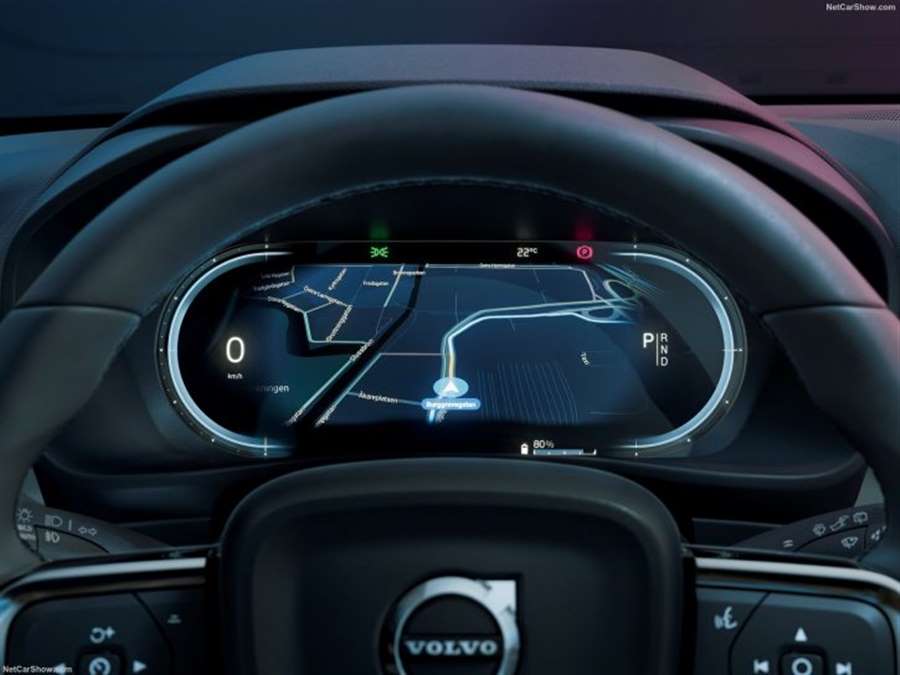
The head of Volvo announced that in addition to the new electric model from the 40 series, more novelties will arrive in the years ahead. As they pointed out from the Sino-Swedish company, they will work a lot on the development of the autonomous driving system.
Another interesting fact that they made public is that the new electric Volvo cars will be sold exclusively online, which already applies to the new C40 Recharge. Investing in online sales will further reduce costs, and after all, a similar strategy is being implemented by Tesla, whose models are officially sold exclusively online.
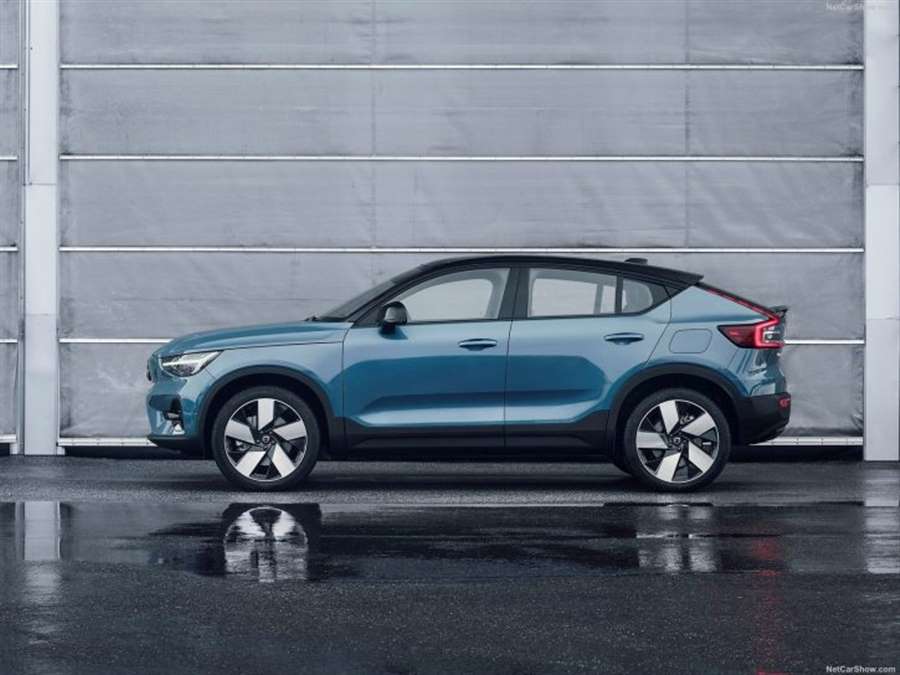
We remind you that many other car companies have recently started announcing plans for a significant acceleration towards full electrification of the market in Europe.
Among them are Daimler, Ford (which will cooperate with VW), JLR and others, while Tesla's first factory in the EU, which is being built in Berlin, will also contribute to this trend.
Also, it is expected that the production of electric cars will be cheaper compared to conventional ones, both due to the new generations of batteries and the smaller number of parts that would be transported and, therefore, the smaller number of workers needed for assembly.
-
Volvo announced an electric SUV
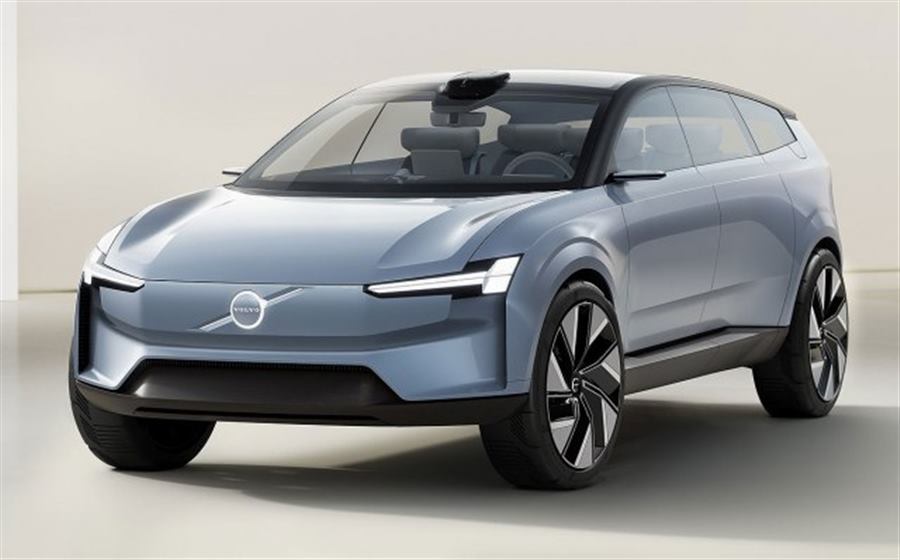
"Later this year, we will reveal our new all-electric flagship SUV," Volvo said.
Originally electric and software defined, it is a demonstration of our future and marks the beginning of a new era of security and company.
For almost 100 years, Volvo's purpose has been to innovate and set new standards to save more lives. With the latest car, the legacy continues with the introduction of new technologies that will help and accelerate progress towards the company's vision:
That no one should be seriously injured or lose their life in a new Volvo car.
"Before we show you the car later this year, Jim Rowan will present our vision for Volvo cars and safety in the future – and offer a first look at some of the new technologies that come as standard on our next all-electric SUV. It will feature innovative features designed to increase your safety as well as those around you," the announcement reads.
-
Volvo C40 Recharge review
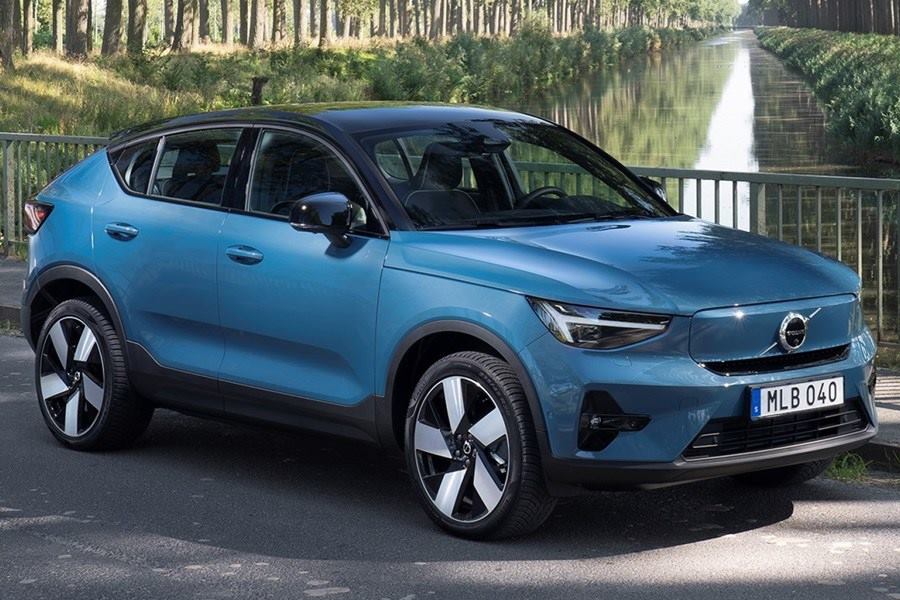
New small electric Volvo offers good looks, acceptable range, strong performance
At a glance
New price £57,400 - £57,400 Lease from new From £717 p/mView lease deals Fuel economy Not tested to latest standardsView pre-2017 economy specsPROS
- Excellent performance
- Surprisingly practical
- Comforable seats and ride
CONS
- Expensive to buy
- Rivals eclipse it for range
- Doesn't feel as special as it should
Is the Volvo C40 any good?
Volvo’s latest ‘small’ car (as small as a Volvo gets, anyway) is this – the C40 Recharge. It marks the first time Volvo’s offered a car that’s exclusively available with electric power, as the mechanically similar XC40 is also offered as a petrol or a plug-in hybrid.
It’s also the brand’s first coupe-SUV, letting Volvo dip its toe in the water of this growing market segment. But the company is confident that its combination of style, cool image and all-electric power will tempt buyers into subscribing to this smart new entrant into the market.
As a small-ish electric car, the C40 has a growing number of rivals. Premium-badged opposition includes the Audi Q4 E-Tron, the Mercedes-Benz EQA and soon the Tesla Model Y. It’ll also be vying for sales with its own siblings – the XC40 Recharge as well as the Polestar 2.
Volvo hopes that the C40’s unique looks, as well as its availability on the ‘Care by Volvo’ subscription plan will endear it to enough people – buyers who want the ownership process to be ‘effortless and joyful’, as the brand says. But there’s a high price to pay for that ease…
What’s it like inside?
The C40 shares most of its interior with the XC40 SUV, and that’s a good thing. Even though the XC40 is a relatively inexpensive car and it’s been largely unchanged since 2017, its interior doesn’t feel out of place on the £57,000+ C40 in 2021.
There are a few changes between the XC40 and the C40, though. The main one is obviously that coupe-like roofline, which you might think makes the back seats and boot very cramped indeed.
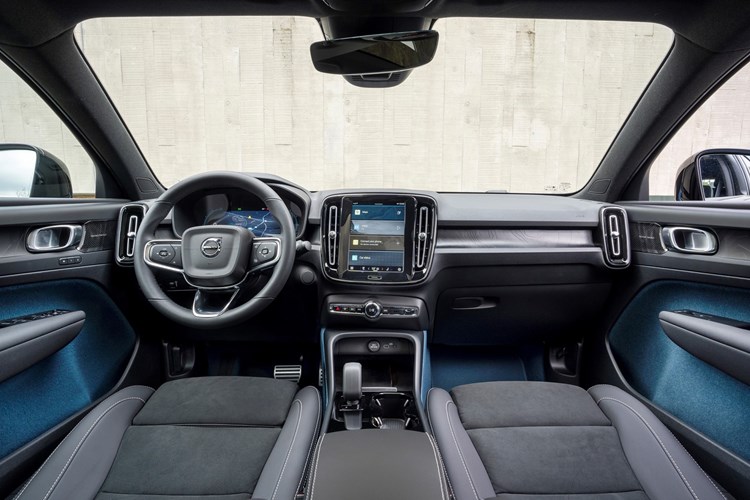
That’s not entirely so, though. The boot is rather small at 413 litres with little loading height, but there’s plenty of legroom in the back and even headroom’s not too badly impacted unless you’re very tall. It’s nowhere near as spacious as an Audi Q4 E-Tron, though.
Another change is the materials used. The C40 is an almost entirely vegan car on the inside – it uses no leather, and aims to minimise the use of animal products wherever possible (though some are almost unavoidable, such as the use of tallow in plastics manufacturing). Upholstery is largely wool-based, or uses microfibre spun from recycled plastic bottles. Not as nasty to sit on as it sounds.
You also get 3D-printed and backlit dashboard panels in place of the faux-aluminium ones on the XC40. They look a bit rubbish in the daylight but really come alive when lit up at night, making for a very cool effect.
Infotainment and tech
The C40 runs Volvo’s latest infotainment software, which is based upon Android Automotive – a Google product. That means that the more you commit to Google’s own ecosystem, the better the infotainment gets – from the built-in Google Maps optimising routes more effectively, to the natural voice commands which are better than any OEM system we’ve used before.
It also opens the door to a whole host of Android apps being available to download from the Play Store in future, which will update over-the-air.
Android Automotive makes the C40 one of the few cars where iPhone users are somewhat left behind. With no Apple CarPlay yet available, you’ll have to commit to a certain amount of Google in your life – perhaps more than many Apple users will be accustomed to.
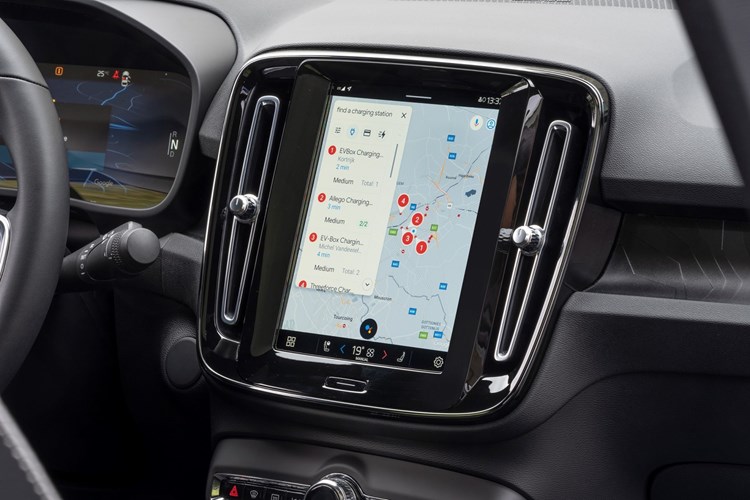
What’s it like to drive?
Simplicity is the name of the game here. The Volvo C40 doesn’t even have a starter button or a parking brake – you simply get in, shift into D and get going.
That simplifying factor carries over into the driving experience, where you won’t find anything so complex as switchable drive modes. Instead there’s only two controls – one to firm the steering up, and one to switch to ‘One-Pedal Drive’, which ramps up the regenerative braking so you can coast to a full stop without touching the brake pedal.
Largely it’s a comfortable experience behind the wheel of the C40. The large wheels of our test car thumped a little around town but on the motorway it settled down to a comfortable ride.
As for performance, it’s impressive. The C40 uses an electric motor on each axle and produces a total of 408hp – that makes for hot hatchback-rivalling pace of 4.7 seconds from 0-62mph. It certainly feels very muscular right up to motorway speeds. We wonder if it wouldn’t feel almost as good with just a single motor, though – that’s an option you can get on the XC40 but it won’t hit the C40 range for a while yet.
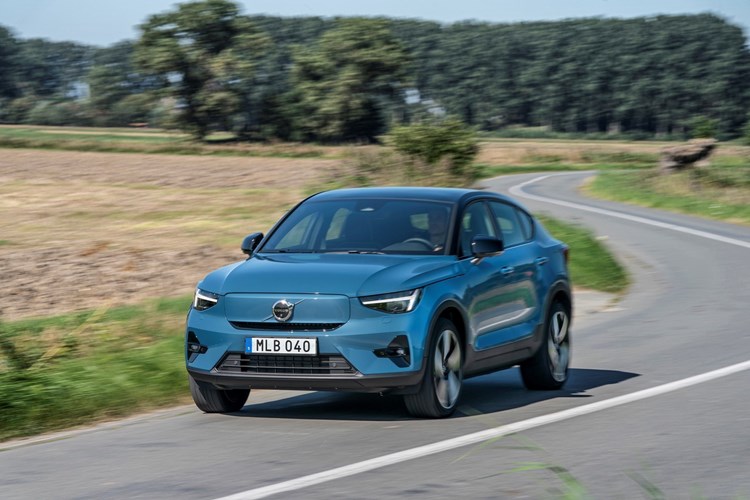
What models and trims are available?
The C40’s only available in one, very highly-specified trim level – the only options are paint colour and a retractable towbar. That means every model gets (deep breath):
- Adaptive LED headlights
- Fixed panoramic sunroof
- 9.0-inch infotainment display
- 12.3-inch digital instrument panel
- Harman Kardon stereo
- Wireless charging
- 360-degree cameras plus all-round parking sensors
- Heated front and rear seats
- Dual-zone climate control
- Pilot Assist (adaptive cruise control + automatic lane-keeping)
Metallic paint and posh upholstery are also a given.
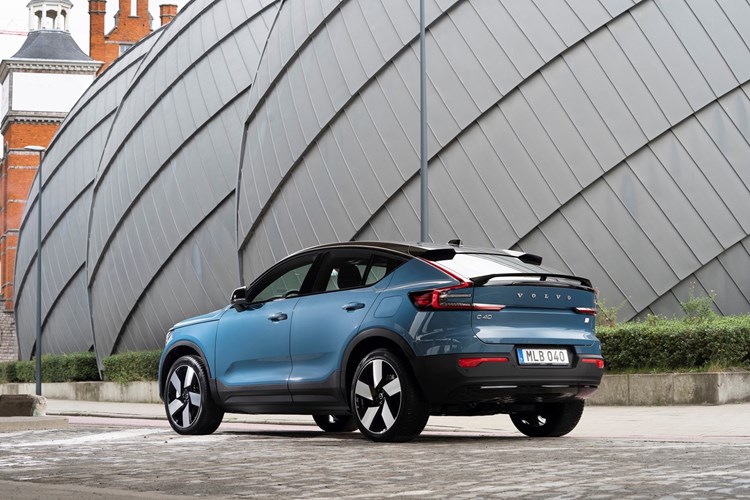
What else should I know?
The C40 Recharge uses the same 78kWh battery pack as the XC40 Recharge. It provides a maximum range of 273 miles on a single charge.
That’s less than you’ll get from an Audi Q4 E-Tron, Tesla Model Y or Polestar 2, but it’s still a thoroughly decent range and should mean at least 200 motorway miles.
Find a 150kW rapid charger and the C40 can be topped up to 80% capacity in just 40 minutes. The onboard charger is of the faster, 11kW type, too, so if your home electricity supply supports a wallbox of this speed then you should be able to top up fully in just eight hours.
Volvo C40 verdict
Should you buy one?
The C40 Recharge is a good electric car, but it doesn’t really feel as though it moves the game on for Volvo or the industry in general. Performance is rapid and it returns an acceptable range on a single charge, but it’s beaten soundly in both aspects by the Tesla Model 3.
And its high price tag means the Volvo C40 is undercut – on cash price or monthly price – by a host of seriously talented cars including the Audi Q4 E-Tron and the Polestar 2.
The Volvo C40 might make a bit more sense later on when cheaper variants arrive in the range – for now, it’s difficult to wholeheartedly recommend unless you’re a serious fan of the way it looks.
(https://www.parkers.co.uk/volvo/c40/review/)
-
Volvo from 2030 on electricity only. And the possibility of shopping only online
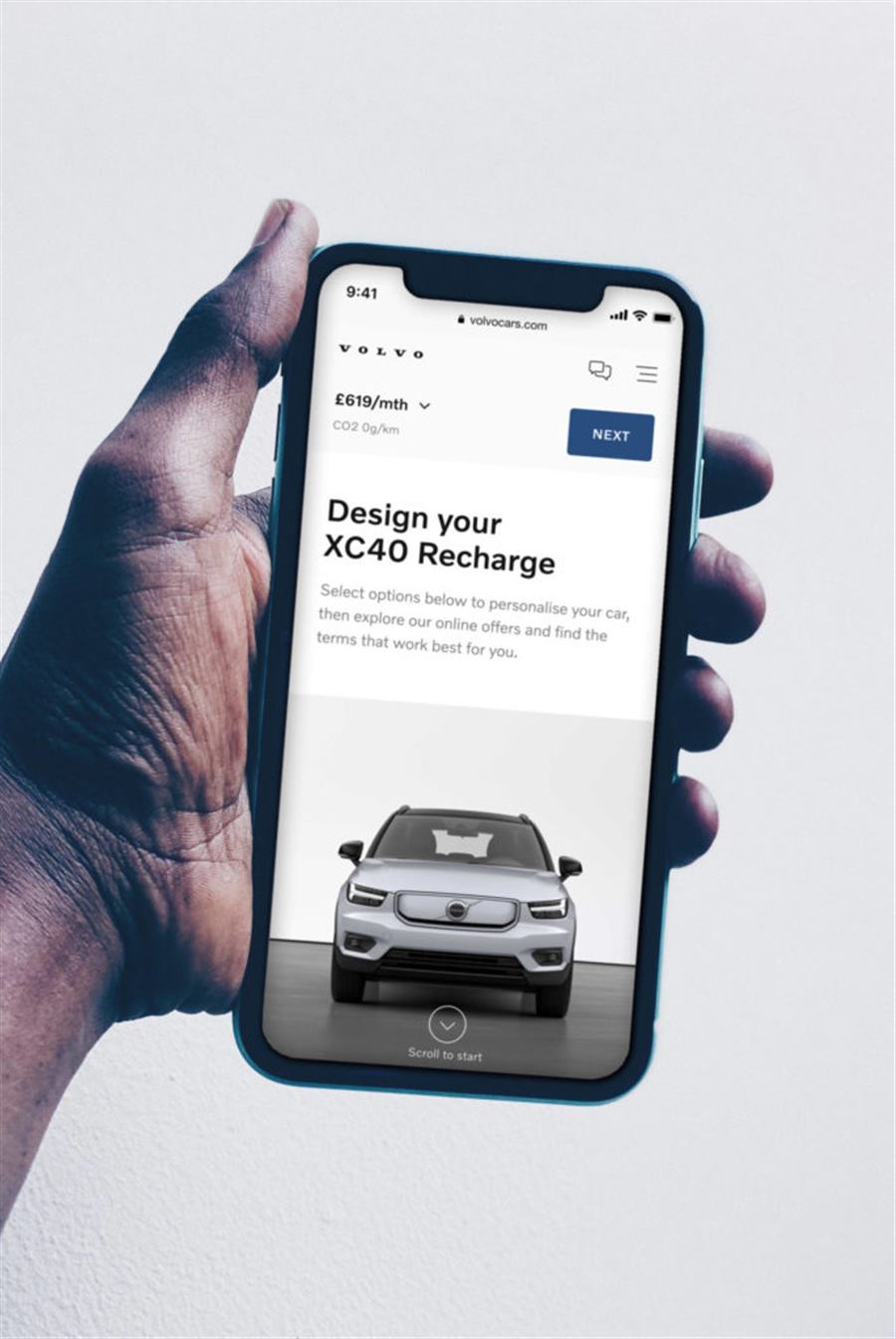
Don't use the Internet and have nowhere to charge your car? Forget Volvo.
Okay, if you don’t use the Internet, you won’t read anything new and you won’t have anything to regret. But Volvo is really turning its business around.
From 2030, every new Volvo will be electric
News has arrived from Sweden that Volvo Cars will be committed to becoming leaders in the fast-growing premium electric car market with a plan to become a fully electric car company by 2030.
Until then, the company will gradually phase out models with internal combustion engines, including hybrids. At Volvo, they expect that legal solutions and the expansion of charging networks will enable this transition to electric cars.
For now, Volvo will only sell its electric vehicles online.
Volvo Cars last year launched its first all-electric car, the XC40 Recharge, in markets around the world. In the coming years, Volvo Cars will introduce several additional electric models. By 2025, the goal is for 50 percent of global sales to consist of fully electric cars, and the rest will be hybrids. By 2030, every car he sells should be fully electric.
And the role of the merchant?
The fight for clients is over - there will be nothing to negotiate here. The buyer buys the car at the price shown on the website, and the seller must prepare it, elegantly hand it over and then service it. In the meantime, they may organize a test drive to help those who are not satisfied by clicking on the page. Volvo emphasizes that the dealer network will be just as important as it is today, but the role of dealers will be limited because electric cars are much simpler. We wonder what interest the owners of car dealerships will have in this approach of the manufacturer? -
Volvo XC40 Review
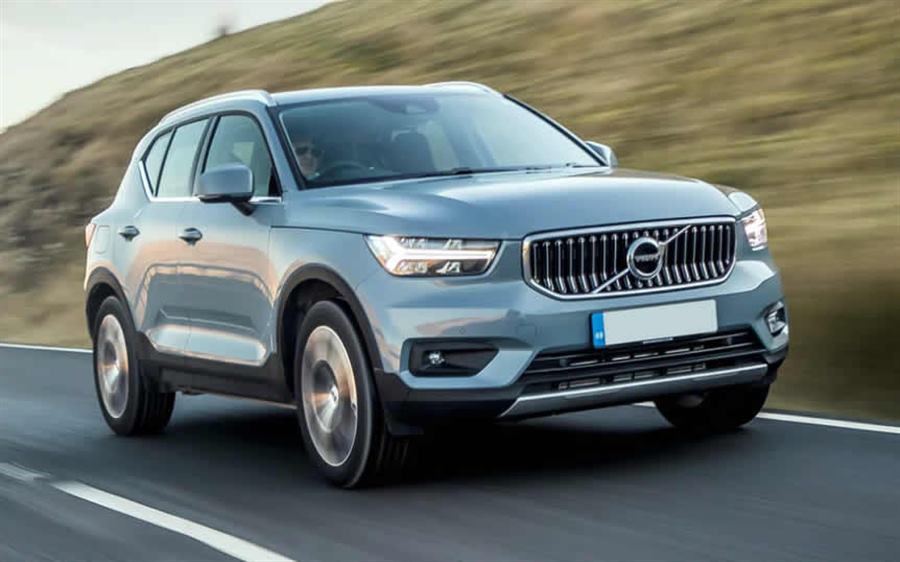
The Volvo XC40 is quite a head-turner. Its tough, chunky SUV styling blends typically Scandinavian minimalism with eye-catching cues, such as an optional two-tone paint scheme where the roof contrasts with the rest of the body.
It also blends typical Volvo virtues like comfort and space with the high driving position and in-town manoeuvrability of a small SUV. Unlike small SUVs from other manufacturers, which have a tendency to be a little like scaled-down copies of larger models (the BMW X1 and X3 spring to mind here), the XC40 its own distinctive style.
In fact, it’s more youthful-looking than its more mature big brother, the XC60 – think of it as funky tee to the XC60’s tailored shirt.
The XC40’s interior still delivers on the minimalist cool you’ve come to expect from modern Volvos, but in this case, there’s a more contemporary tone. Examples of this include the door trims, armrest and handles, which are made out of a single piece of plastic and have colour-coded felt-lined inlays. This design not only adds a dash of vibrancy to the cabin but also frees up space for larger capacity door bins.
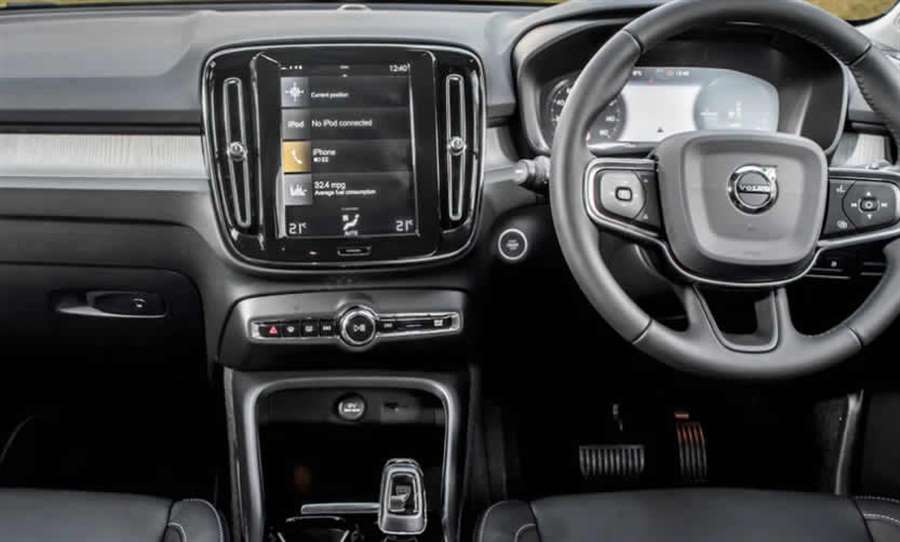
Cleverly thought-out storage solutions are a bit of a theme in the XC40 – the central armrest features a removable section that can work as a small waste paper bin, while the large, well-shaped boot offers a pop-up divider to help hold shopping bags in place. Both front-seat and rear-seat occupants will have plenty of space, too, and as a driver, you’ll find it easy to find an ideal driving position whether you’re small or tall.
There are some imperfections, though. Poke around a bit and you’ll notice some trim pieces feel of poorer quality than you might find in an Audi Q3. And, while the portrait-style infotainment system may look smart, being a touchscreen, it isn’t as easy to use when you’re driving as the rotary controller you get in a BMW X1.
Speaking of which the BMW is the slightly more fun car to drive. Yet that doesn’t mean the Volvo XC40 leans like a listing ship in the bends – it handles as well as you need an SUV to handle. And it gets the basics spot on. It’s comfy over bumps, effortless in town, and relaxing on the motorway.
Okay, so the engines and gearboxes in the XC40 aren’t quite as good as those in the comparative German models but this shouldn’t be a dealbreaker. The entry-level T3 petrol is punchy enough for town use and, if you do lots of miles, the economical D3 diesel is more than up to the job. You don’t really need to pay extra for the more powerful engines, although company car drivers should keep in mind the Recharge plug-in hybrid models because they’ll be the cheapest to own.
There are some upgrades worth considering though. The Volvo XC40 is one of the safest new cars on the road as standard, but it is available with extra kit such as blind-spot monitoring. You can also get an advanced cruise control system which will keep you a safe distance from the car in front, will steer to keep you in lane and even work in stop-start motorway traffic.
Of course, all this adds to the price, but the XC40 is still quite competitive for a posh small SUV – but check out our Volvo XC40 deals to see how much you can save on one. Or click the links below to get offers on our recommended XC40 model.
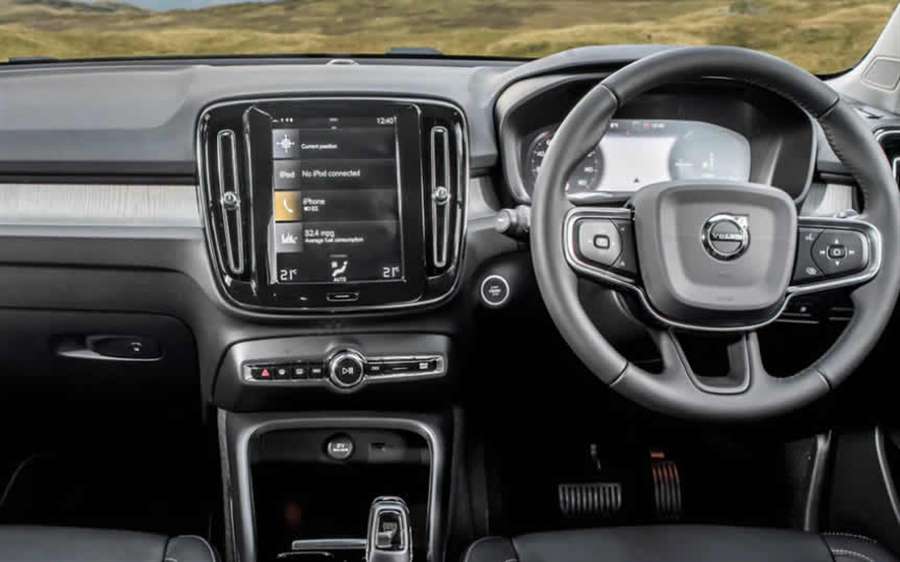
How practical is it?
The Volvo XC40’s interior has room for four adults and an impressive amount of storage space in the doors. The boot isn’t the largest, but it is well designed and packed with features
What's it like inside?
The Volvo XC40’s interior has a classy minimalist design and an eye-catching infotainment screen. Sadly, it’s not the easiest system to use and the XC40 also suffers from patchy build quality.
Volvo XC40 interior
The Volvo XC40’s interior has a classy minimalist design and an eye-catching infotainment screen. Sadly, it’s not the easiest system to use and the XC40 also suffers from patchy build quality.
Style
The Volvo XC40’s interior has a premium look and feel that marks it out from well-built but dowdy mainstream alternatives such as the Volkswagen Tiguan. In fact, it’s classy enough to be considered an alternative to posh SUVs such as the Mercedes GLA, Audi Q2 and BMW X1.
That said, none of them have the Volvo XC40’s portrait style, 9-inch infotainment screen. It means that conventional buttons are kept to a neat single row in the centre of the dash, including a large volume knob in the centre that is easy to reach for when you’re on the move.
The infotainment system’s design is exactly as you’ll find on larger Volvos, but the XC40’s youthful, bright Lava Orange carpet and door trims (available as an option on R-Design models) certainly aren’t.
That’ll help the XC40 appeal to you if you’re young. You’ll also like its soft-to-the-touch plastics and expensive-looking trims. The only problem is the construction, which has inconsistent gaps between panels that you wouldn’t find in an Audi Q2.
On the upside, even entry-level Volvo XC40 Momentum models get textile-vinyl (friends will assume they’re half-leather) seats and Urban Grid Aluminium trim pieces that look very nice.
Sportier-looking R-Design models get leather-nubuck upholstery, a leather-trimmed steering wheel and gear knob, as well as aluminium inlays.
Inscription models are the poshest, and come with a full leather interior and unvarnished wooden trim pieces that looks as good as anything Mercedes has to offer.
If you’ve ever used an Apple iPad then you’ll have no problem operating the Volvo XC40’s 9-inch infotainment display. It lets you swipe between menus and pinch to zoom in on maps, and has a conventional ‘home’ button at the bottom of the screen so you can skip quickly to the main menu.
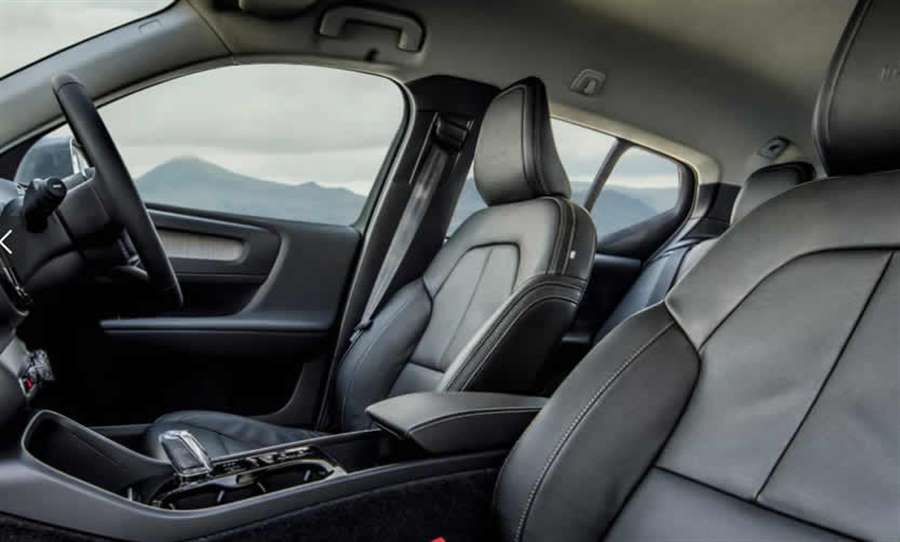
Entering a postcode is easily done while you’re parked – either by writing in the letters with your finger or by typing them in via the onscreen keyboard – but it’s fiddlier to do when you’re driving than it is in the BMW X1 or Audi Q2.
In fairness, the Volvo XC40 wins some points back by offering an app for your smartphone, so you can programme the sat-nav without even having to leave the house. You can also use it to preset the cabin temperature or open the car remotely.
On top of the central infotainment screen, you get another 12.3-inch digital driver’s display that’s an option on the BMW and Audi. It’s customisable, so you can flick between conventional dials or having a large map display for the sat-nav right in front of your eyes.
Completing the Volvo XC40’s audio-visual package is a standard stereo that has a very healthy 250W output and eight speakers. That should be enough for casual music fans, but if you’re a full-blown enthusiast you’ll want to tick the box for the 13-speaker, 650W Harman Kardon system that can envelop you in a wave of sound.
Source: carwow.co.uk
-
Volvo XC40 Review
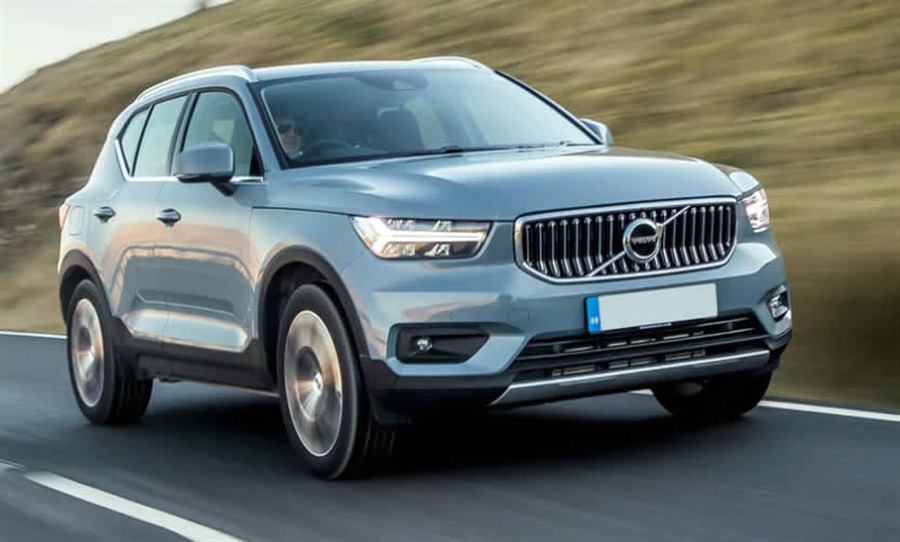
The Volvo XC40 is a spacious small SUV with smart styling and a comfortable drive. Some of the interior trims aren’t quite up to scratch and you might find the infotainment system fiddly.
Is the Volvo XC40 a good car?
The Volvo XC40 is quite a head-turner. Its tough, chunky SUV styling blends typically Scandinavian minimalism with eye-catching cues, such as an optional two-tone paint scheme where the roof contrasts with the rest of the body.It also blends typical Volvo virtues like comfort and space with the high driving position and in-town manoeuvrability of a small SUV. Unlike small SUVs from other manufacturers, which have a tendency to be a little like scaled-down copies of larger models (the BMW X1 and X3 spring to mind here), the XC40 its own distinctive style.
In fact, it’s more youthful-looking than its more mature big brother, the XC60 – think of it as funky tee to the XC60’s tailored shirt.
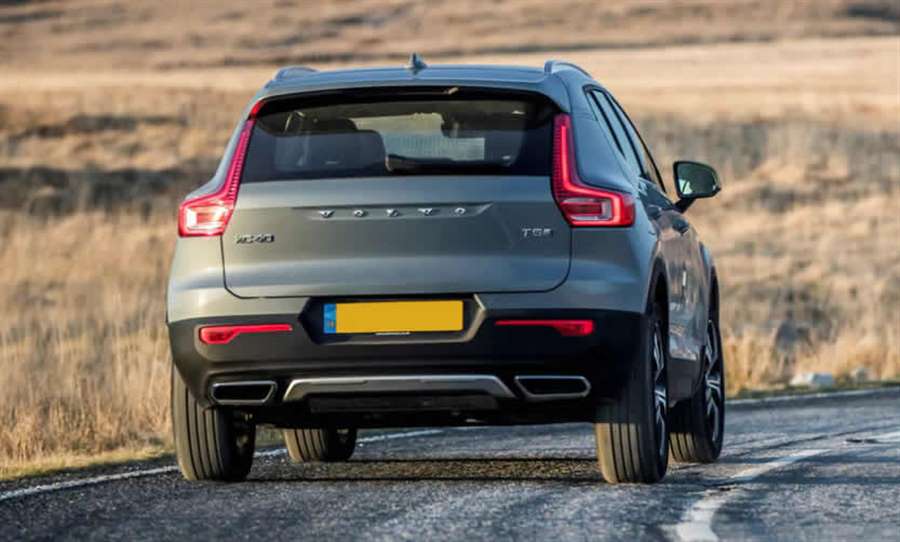
The XC40’s interior still delivers on the minimalist cool you’ve come to expect from modern Volvos, but in this case, there’s a more contemporary tone. Examples of this include the door trims, armrest and handles, which are made out of a single piece of plastic and have colour-coded felt-lined inlays. This design not only adds a dash of vibrancy to the cabin but also frees up space for larger capacity door bins.
Cleverly thought-out storage solutions are a bit of a theme in the XC40 – the central armrest features a removable section that can work as a small waste paper bin, while the large, well-shaped boot offers a pop-up divider to help hold shopping bags in place. Both front-seat and rear-seat occupants will have plenty of space, too, and as a driver, you’ll find it easy to find an ideal driving position whether you’re small or tall.
The Volvo XC40 is a bit of a cracker. It's a sophisticated SUV with an upmarket feel and the icing on the cake is that it's really easy to live with.
There are some imperfections, though. Poke around a bit and you’ll notice some trim pieces feel of poorer quality than you might find in an Audi Q3. And, while the portrait-style infotainment system may look smart, being a touchscreen, it isn’t as easy to use when you’re driving as the rotary controller you get in a BMW X1.

Speaking of which the BMW is the slightly more fun car to drive. Yet that doesn’t mean the Volvo XC40 leans like a listing ship in the bends – it handles as well as you need an SUV to handle. And it gets the basics spot on. It’s comfy over bumps, effortless in town, and relaxing on the motorway.
Okay, so the engines and gearboxes in the XC40 aren’t quite as good as those in the comparative German models but this shouldn’t be a dealbreaker. The entry-level T3 petrol is punchy enough for town use and, if you do lots of miles, the economical D3 diesel is more than up to the job. You don’t really need to pay extra for the more powerful engines, although company car drivers should keep in mind the Recharge plug-in hybrid models because they’ll be the cheapest to own.
There are some upgrades worth considering though. The Volvo XC40 is one of the safest new cars on the road as standard, but it is available with extra kit such as blind-spot monitoring. You can also get an advanced cruise control system which will keep you a safe distance from the car in front, will steer to keep you in lane and even work in stop-start motorway traffic.
Of course, all this adds to the price, but the XC40 is still quite competitive for a posh small SUV – but check out our Volvo XC40 deals to see how much you can save on one. Or click the links below to get offers on our recommended XC40 model.
How practical is it?
The Volvo XC40’s interior has room for four adults and an impressive amount of storage space in the doors. The boot isn’t the largest, but it is well designed and packed with featuresWhat's it like inside?
The Volvo XC40’s interior has a classy minimalist design and an eye-catching infotainment screen. Sadly, it’s not the easiest system to use and the XC40 also suffers from patchy build quality.Volvo XC40 interior
The Volvo XC40’s interior has a classy minimalist design and an eye-catching infotainment screen. Sadly, it’s not the easiest system to use and the XC40 also suffers from patchy build quality.

Style
The Volvo XC40’s interior has a premium look and feel that marks it out from well-built but dowdy mainstream alternatives such as the Volkswagen Tiguan. In fact, it’s classy enough to be considered an alternative to posh SUVs such as the Mercedes GLA, Audi Q2 and BMW X1.
That said, none of them have the Volvo XC40’s portrait style, 9-inch infotainment screen. It means that conventional buttons are kept to a neat single row in the centre of the dash, including a large volume knob in the centre that is easy to reach for when you’re on the move.
The infotainment system’s design is exactly as you’ll find on larger Volvos, but the XC40’s youthful, bright Lava Orange carpet and door trims (available as an option on R-Design models) certainly aren’t.
That’ll help the XC40 appeal to you if you’re young. You’ll also like its soft-to-the-touch plastics and expensive-looking trims. The only problem is the construction, which has inconsistent gaps between panels that you wouldn’t find in an Audi Q2.
On the upside, even entry-level Volvo XC40 Momentum models get textile-vinyl (friends will assume they’re half-leather) seats and Urban Grid Aluminium trim pieces that look very nice.
Sportier-looking R-Design models get leather-nubuck upholstery, a leather-trimmed steering wheel and gear knob, as well as aluminium inlays.
Inscription models are the poshest, and come with a full leather interior and unvarnished wooden trim pieces that looks as good as anything Mercedes has to offer.
Infotainment
If you’ve ever used an Apple iPad then you’ll have no problem operating the Volvo XC40’s 9-inch infotainment display. It lets you swipe between menus and pinch to zoom in on maps, and has a conventional ‘home’ button at the bottom of the screen so you can skip quickly to the main menu.Entering a postcode is easily done while you’re parked – either by writing in the letters with your finger or by typing them in via the onscreen keyboard – but it’s fiddlier to do when you’re driving than it is in the BMW X1 or Audi Q2.
In fairness, the Volvo XC40 wins some points back by offering an app for your smartphone, so you can programme the sat-nav without even having to leave the house. You can also use it to preset the cabin temperature or open the car remotely.
On top of the central infotainment screen, you get another 12.3-inch digital driver’s display that’s an option on the BMW and Audi. It’s customisable, so you can flick between conventional dials or having a large map display for the sat-nav right in front of your eyes.
Completing the Volvo XC40’s audio-visual package is a standard stereo that has a very healthy 250W output and eight speakers. That should be enough for casual music fans, but if you’re a full-blown enthusiast you’ll want to tick the box for the 13-speaker, 650W Harman Kardon system that can envelop you in a wave of sound.
Source: carwow.co.uk
-
Volvo XC40 review
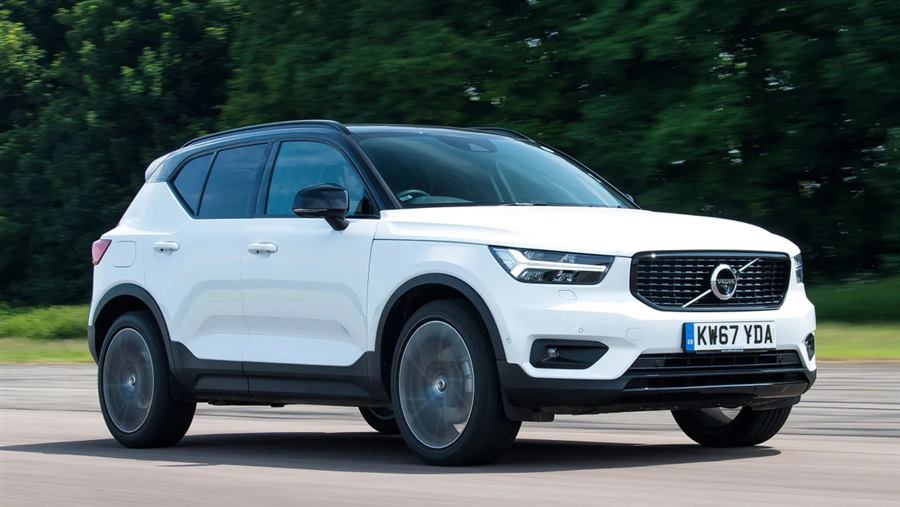
The Volvo XC40 is a comfortable and stylish small SUV that has some pleasing practical touches and a lot of Swedish cool
Verdict
The Volvo XC40 is a strong contender in the market for small premium SUVs. It’s not a revelation on the road, but it strikes a decent blend of comfort and cruising refinement, and offers premium SUV appeal in a small-car package. This allows passengers to enjoy the funky, minimalist cabin and the capable infotainment system.Factor in competitive pricing when compared to rivals, as well as Volvo's traditional focus on safety, and you’re left with one of the most appealing offerings on the market. That's why we made the XC40 our Small Premium SUV of the Year in our 2018 New Car Awards.
About the Volvo XC40
Introduced in 2017, the Volvo XC40 is a mid-sized premium SUV that majors on practicality and comfort while offering bold styling that helps set it apart from its more conservative rivals. Its great safety rating and suite of available active safety systems will appeal to customers, too.
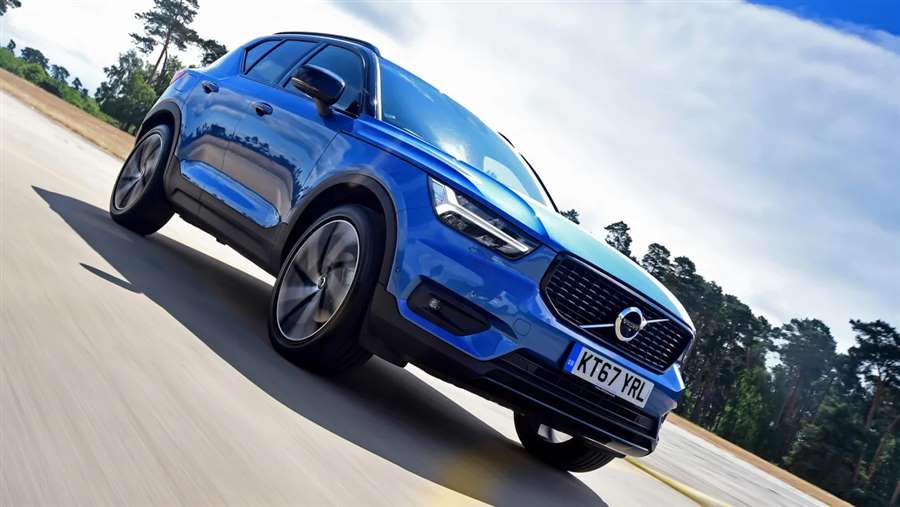
n terms of size and price, the XC40 slots into the Volvo SUV range below the XC60 and XC90, and is offered in Core, Plus and Ultimate trims.
There's a similar engine range too, and the XC40 receives the latest mild-hybrid ‘B’ engines from its bigger siblings. You can also buy plug-in hybrid and fully electric versions. Volvo aims to launch a fully electric car every year, as it seeks to make all-electric cars 50 per cent of global sales by 2025, with the rest hybrids. Recharge will be the overarching name for all chargeable Volvos with a fully electric and plug-in hybrid powertrain.
Rivals for the Volvo XC40 include the BMW X1 and X2 duo, the Jaguar E-Pace, Land Rover Discovery Sport, Range Rover Evoque, Audi Q2 and Q3 and Mini Countryman.
Where the XC40 stands out is with its fresh looks. The chunky lines define it as an SUV, yet its compact dimensions mean it's no more manageable than a compact hatchback.
Inside, the XC40 focuses on style, with a design-led interior that uses digital displays and quality materials to create an upmarket cabin which can be upgraded with a variety of individual options. Power comes from a range of three and four-cylinder petrol engines, along with B-badged mild-hybrid petrol versions.
The range kicks off with a B3-badged 161bhp petrol, then a 194bhp B4, while the 247bhp four-cylinder B5 is no longer available. The B3 is front-wheel drive and every version gets an eight-speed automatic as standard, while the B4 is offered with front- or all-wheel-drive.
The 208bhp Recharge T4 and the 258bhp Recharge T5 plug-in hybrids stick to front-wheel drive and an automatic gearbox, while Volvo has also introduced the XC40 P8 pure electric model with all-wheel-drive and 402bhp, along with a 228bhp all-electric Single Motor version.
Volvo previously matched a basic Start trim with the lower-powered 1.5-litre T2 petrol engine to create a single entry-level model, but this is no longer available. There are now three main trim levels – Core, Plus and Ultimate, which offer lots of kit as standard.
The Core model is well catered for, although there is a significant asking price of around £35,000. It comes with dual-zone climate control, 18-inch wheels, rear parking sensors, a powered boot, auto-folding door mirrors, cruise control and digital instruments all included. Also on board is Volvo’s excellent nine-inch portrait-layout infotainment system.
Plus adds extra kit such as a rear-view camera, keyless entry, a hands-free opening boot, heated front seats, a heated steering wheel and even a heated windscreen.
Ultimate is the plushest XC40, bringing a 12-speaker Harman Kardon stereo system, panoramic sunroof, adaptive Pixel LED headlights and a 360-degree camera view.
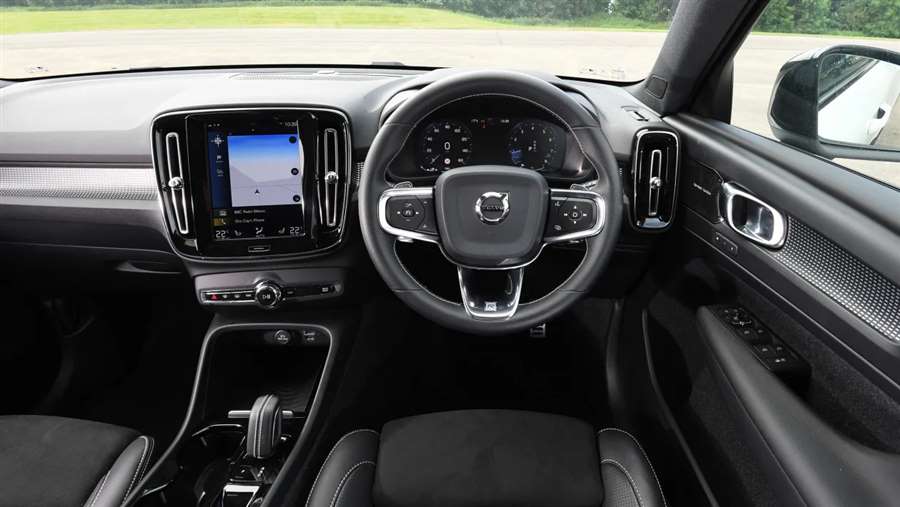
Volvo XC40 review - Engines, performance and drive
The XC40 majors on comfort and refinement instead of driving entertainment, and it does so rather well
The XC90 and XC60 are both based on Volvo’s Scalable Product Architecture (SPA) platform, but the XC40 is the first model from the Swedish brand to sit on the Compact Modular Architecture (CMA) underpinnings. This uses MacPherson strut suspension at the front and a multi-link rear axle, which means the new Volvo matches its German rivals for chassis technology under the skin. However, if you’re looking for dynamic sparkle and hot hatchback-rivalling agility down a country road, you’ll be better off elsewhere.
For everyone else, though, the XC40 strikes a nice balance between composure and comfort. It can get caught out on pockmarked city streets, particularly at low speeds and on the optional larger wheels - but provided you stick with the original items, you’re likely to find the baby Volvo a pretty relaxing place to spend time. This isn’t just down to ride quality, of course, because the engines do a good job of fading into the background too.
The engine does its best work between 1,500rpm and 3,000rpm, and the eight-speed auto is keen to shift up just before the higher of those figures. It’s nicely judged, really, because that’s also the point where the motor really identifies itself as a diesel, through a harsher note and increased volume.
It’s worth remembering, though, that should you want to get more involved in the gearshifting process, not every version is available with steering wheel-mounted shift paddles. And this restriction is compounded by the fact that the stubby gear selector between the front seats actually has a lateral shift pattern - pull it towards the driver to shift down, and push it towards the passenger to shift up. It’s a bizarre layout that will take even the most adaptable of drivers a long time to get used to.
Even on those optional wheels, at high speeds the XC40 does a good job of soaking up road imperfections. You’ll occasionally notice a slight floating effect, but it never strays to the point of making you seasick. Its trickiest moments come at low speeds around town, where you might find the car troubled by deep potholes. Then again, we’d expect a standard Momentum on 18-inch wheels to demonstrate a bit more compliance in this regard.
It wouldn’t be unreasonable to expect such a generally wafty small SUV to be boat-like in corners, but in fact, the XC40 stays composed, even when required to perform a sudden, rapid change of direction. The steering adds to the experience - not because it’s blessed with any great deal of feedback, but rather because it’s nicely weighted and pleasingly direct. Playing around with the car’s Drive Mode selector and switching it into Dynamic actually has a negative effect, in fact, because it adds heft to the steering instead of any discernible extra communication.
Ultimate models fitted with 19-inch alloy wheels feel firm on typically torn UK roads. The chassis deals with more flowing undulations well, but sharper bumps shock the chassis, whereas a BMW X1 smothers imperfections a little more adeptly.
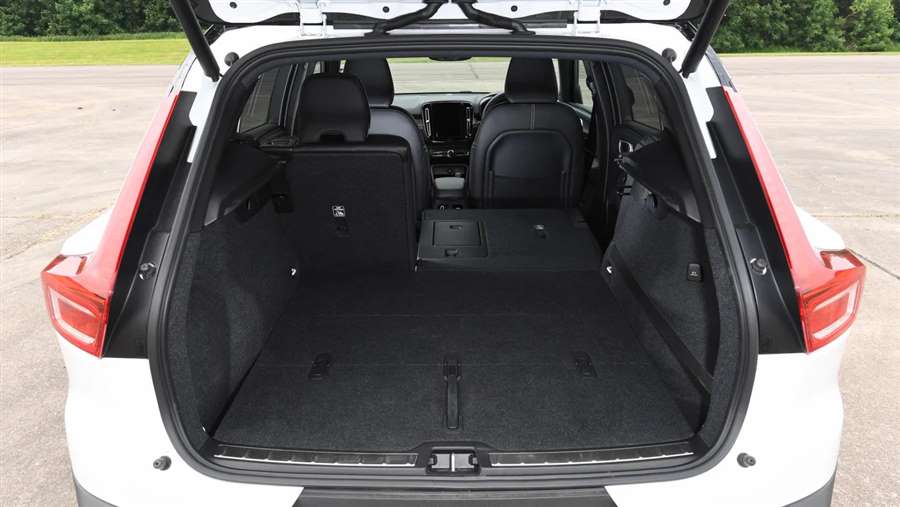
However, light steering and a well-judged chassis set-up means that the Volvo does at least respond well to inputs. It’s not as involving or as quick to change direction as the BMW, but for a tall SUV with a relatively short wheelbase, it offers a decent level of composure.
The XC40 has a mix of full electric, hybrid and turbocharged petrol engine options – with some petrol models having been refreshed in 2019 to offer more power and improved economy. The range starts with the mild-hybrid B3 four-cylinder petrol, producing 161bhp with a seven-speed automatic gearboxes. All B3 models are front-wheel drive.
Step up to the B4 with 194bhp and an automatic gearbox also comes as standard, but there's the choice of front- or four-wheel drive.
The 258bhp Recharge plug-in hybrid T5 model is powered by a 1.5-litre three-cylinder mated to an electric motor. It’s an impressive unit – with all that battery assistance, the three-cylinder motor feels like it lives a relatively unstrained life, but it’s capable of a proper turn of pace. Volvo’s claimed 7.3-second 0-62mph time points to solid performance, owing to the strong reserves of torque the XC40 Recharge can muster, and it does it with so much refinement too.The cheaper Recharge T4 plug-in hybrid version produces 208bhp and gives away 1.2 seconds to its more powerful sibling in the sprint to 62mph.
Volvo has also added the 402bhp P8 pure electric Recharge model to the range. It makes use of two electric motors powered by a 78kWh battery and is capable of 0-62mph in a claimed 4.9 seconds. The 228bhp Single Motor version (with a 69kWh battery) needs a more leisurely 7.4 seconds to complete the benchmark sprint.
Volvo XC40 review - MPG, CO2 and running costs
Ballpark fuel efficiency, with respectable CO2, but the real gains come with the Recharge plug-in hybrid and pure-electric versions
The XC40’s engine line-up comprises state-of-the-art motors, with a wide range of electric, hybrid and petrol units. The efficiency figures on the XC40 are respectable for the class, but no better than that.
The cleanest XC40 models are the Recharge P8 pure electric and Single Motor which emit 0g/km. Next up are the Recharge T4 and T5 plug-in hybrid models which emit 47-49g/km, depending on chosen specification.
As you might expect, the standard petrol XC40 takes a hit on fuel efficiency and CO2 emissions; at 152g/km for the B3, it's probably a big enough tax hit for lots of company car choosers to overlook it. In reality, it’s a very thirsty unit, too - we struggled to get mid-thirties mpg out of the B3 in our time behind the wheel. The front-wheel drive B4 with mild-hybrid tech offers greater performance than the B3, and the same returns in real world economy.
Insurance groups
Insurance groups for the XC40 range from Group 18 to Group 32. On a like-for-like basis, the Volvo is ranked slightly lower than its German rivals - not least helped because of the Swedish brand’s reputation for passive and active safety systems.Depreciation
Volvo is currently on the crest of wave in terms of customer demand, and when you also factor in the strong desirability within the premium SUV market, it's no surprise that the XC40 has strong residual values; 53 per cent for the all-electric models, and 57-62 per cent for mild-hybrid petrol and plug-in hybrid models.Volvo XC40 review - Interior, design and technology
Bags of Swedish cool, with a clean, uncluttered design that still manages to incorporate some lovely practical touches
Volvo has deliberately moved the XC40 away from the more luxurious, grown-up presence offered by the larger XC60 and XC90 models – but that doesn’t mean there’s no scope for impressive design touches or the latest technology. Quite the opposite, in fact, because the baby Volvo brings something new to the premium small SUV market.
The car’s styling was inspired by small robots that the British designer, Ian Kettle, saw in science-fiction movies. The end result is lots of simple, clean, resolved lines - and a look that manages to look chunky and cute at the same time. It’s helped by a further evolution of Volvo’s ‘Thor’s Hammer’ headlight motif at the front end.
There’s more scope for personalisation than on the XC60 and XC90 too, thanks to contrast roof colours on some versions (black or white, depending on the trim level).
Inside, there’s not a great deal in the way of opulence - and yet the XC40 still manages to deliver a dose of Swedish cool, much in the same way as a well-resolved IKEA living room display. There’s remarkably little clutter and although the actual amount of space isn’t any greater than the class average, the Volvo’s plethora of neat practical touches makes the XC40 feel a lot more ‘real-world liveable’ than many of its rivals.
Technology helps with this too, of course. And in this respect, a slice of shameless carryover from the XC60 and XC90 works wonders – because the XC40 gets the same nine-inch portrait-layout infotainment display as its larger brothers, as well as a 12.3in digital instrument panel instead of conventional dials. These are standard across the range, too.
Sat-nav, stereo and infotainment
The XC40 uses a new Android-based operating system with built-in online Google services. It’s still displayed on a nine-inch portrait-oriented display, but the graphics are sharper and the shortcut keys bolder and less fiddly to use than previous Volvo set-ups – although they are still on the small side.
Loading times are good, however; the process from typing an address to the system loading the first navigation instruction took just 18 seconds, and Google’s live traffic info means the route and time to destination will be accurate, too.
There’s only one physical control; a single button below the screen takes you back to the home page, and the air-con settings are adjusted through the screen. For a first-time user, the set-up takes a little getting used to, but it’s hard to fault if you link it to a Google account.
Volvo XC40 review - Practicality, comfort and boot space
A well-judged amount of cabin space and some neat features to help maximise boot space make the XC40 more than practical enough
The XC40 enters a class where style and image have traditionally been more important than genuine space. But while the Volvo doesn’t deliver an aircraft hangar’s worth of room in the cabin, it manages to do enough to stand out from the crowd.
The XC40’s interior is neat, functional and, in its own way, very Swedish. If you’re absolutely set on having soft-touch fabrics and squishy plastic on the dashboard then you’ll probably judge it a disappointment, but the rest of us should find the interior a pretty special place to spend time.
The facia has relatively few switches, and a clean, uncluttered look. And depending on the trim you choose, and your bravery with the options list, there’ll be a vibrant flock lining in the enormous door bins to offer a dash of funky colour. The capacity of these door cubbies is huge, in fact - helped by Volvo’s decision to move the speakers out of their traditional area and arrange a sound system based around the top of the dashboard instead.
There are plenty of simple, clever touches, too. You’ll find a folding hook integrated into the glovebox that is designed to help you make it home without spilling a drop of your chicken chow mein. The rather flimsy-looking lidded compartment between the front seats turns out to be a removable, washable bin. And there’s also the option of a wireless phone charging pad and USB port at the base of the centre console.
A lengthy wheelbase helps with rear legroom - although the amount of headroom for back-seat passengers is equally impressive, even with the optional panoramic sunroof fitted. There’s plenty of room on board for four grown-ups, although a fifth adult may complain about the high transmission tunnel.
The boot isn’t the largest in the class, but the floor is commendably flat and there are some clever (optional) dividers that help to stop your shopping from rolling around when you’re on the move.
The Volvo XC40 is 4,425mm long, 1,863mm wide and 1,658mm tall. That makes it a little shorter than the BMW X1, but longer than an Audi Q3 - and it’s notably wider and taller than both of those rivals, too.
Leg room, head room & passenger space
Expect the XC40 to provide a cavernous cabin and you’ll be disappointed. But what the Volvo does do is maximise the potential of what space is on offer.
There’s plenty of space for two adults up front, and you’ll be able to fit a couple of grown-ups in the back seats easily too. The XC40 has a pretty long wheelbase, so they should be fine for legroom - and the amount of headroom for back-seat passengers is equally as impressive, even with the optional panoramic sunroof fitted.
Can you squeeze a third person into the rear seats? Yes, at a push. But there’s a transmission tunnel running down the middle of the floor, so they may complain about having to place their feet at either side of it.
Boot
The XC40 doesn’t boast the largest load bay in its class, but it’s easy to use what space is on offer there. That’s because the 452-litre boot has an impressively flat floor, with no lip at the front edge, so it’s easy to slide heavier items in there.Spec the Convenience Pack and you’ll get a folding boot floor that can divide the space and stop your shopping from rolling around. The hinges even stand proud of the top edge of the resulting divider, giving you a few extra points from which to hang shopping bags.
Customers won't be short of room if they opt for one of the Recharge models, either. These cars include batteries that line the car’s spine, which crucially leaves the standard boot space unaffected. Due to the lack of an internal combustion engine, the Recharge P8 pure electric version also has an extra 30-litre storage bin under the bonnet.
Towing
The all-electric XC40 Recharge Single Motor is rated to tow up to 1,500kg, while the T4 and T5 plug-in hybrid models are both able to pull 1,800kg. The B3 petrol splits the difference with a 1,600kg maximum braked trailer weight, while buyers prioritising towing ability will be better served by the B4 version which has a 2,000kg limit in front-wheel-drive form and 2,100kg with an all-wheel-drive set-up.Volvo XC40 review - Reliability and safety
A new platform, but some proven engines should help to keep the XC40 reliable. Bags of top-notch Volvo safety kit on board, too
The XC40 is built on Volvo’s latest CMA platform - and that means that its underpinnings are, in theory, relatively unproven. However, the Swedish firm has designed the chassis to accommodate its family of four-cylinder and three-cylinder petrol and diesel engines and hybrid motors and battery packs, many of which have seen use in other models before.
This, and the fact that the Volvo gets other components from larger stablemates (such as the infotainment system and some switches) should help it to achieve a pretty decent level of reliability.
Volvo finished ninth out of 29 manufacturers in our 2021 Driver Power customer satisfaction survey, with a one place jump to eighth overall in 2022. The XC40 achieved 23rd spot out of 75 cars in the best cars to own poll.
Safety continues to be a big priority for Volvo, and the XC40 doesn't disappoint. It scored five stars out of five in the Euro NCAP test, with an impressive 97 per cent for adult occupant protection and 87 per cent for child occupant protection. You get automatic emergency braking across the range – and it’s capable of spotting not only cars but also pedestrians and large animals. Plus every XC40 gets a lane departure system, which will intervene and pull the car back into lane if it senses you’re going to steer into the path of oncoming traffic.
Warranty
The XC40 comes with a three-year warranty, which is par for the course in the class, although the mileage limit for the cover is 60,000 miles instead of the industry-standard 36,000 miles.Servicing
Volvo offers fixed-price service plans for its cars that can be paid for up front or on a monthly basis. These can last from two-five years and cover annual mileages up to 50,000 miles.As a typical example, you can get three years of cover for around £1,000, although this can be added to any finance deal you may take out, which works out at around £30 extra a month on a three-year finance deal.
Source: autoexpres.co.uk
-
Volvo XC90 hybrid Recharge T8 (2020) review: posh power
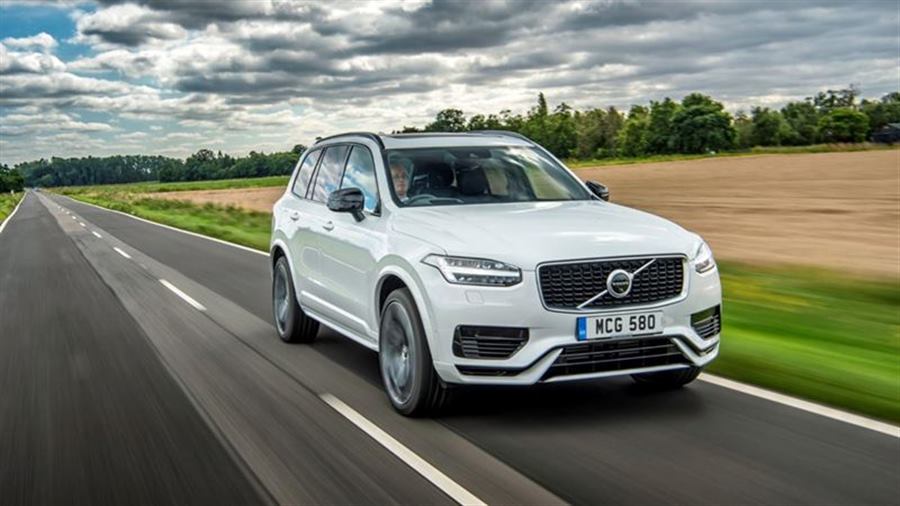
► 400bhp, 100mpg, 0-62 in 5.8seconds
► Swedish seven seater
► Frugal and fast - but not at the same timeBack when Elon Musk was merely known for crashing his McLaren F1 and Jeff Bezos was a bookseller, Volvos were safe and sturdy cars made for ferrying around your offspring.
Fast forward to today and the brand has evolved into a stylish desirable car marque that no longer just trades off being the safest around.
Keep hitting the fast forward button and you'll see that a new Volvo XC90 is due in 2021. It'll be a hybrid and EV only affair.
With this in mind - is the XC90 worth buying still? Or should people wait for the new car?
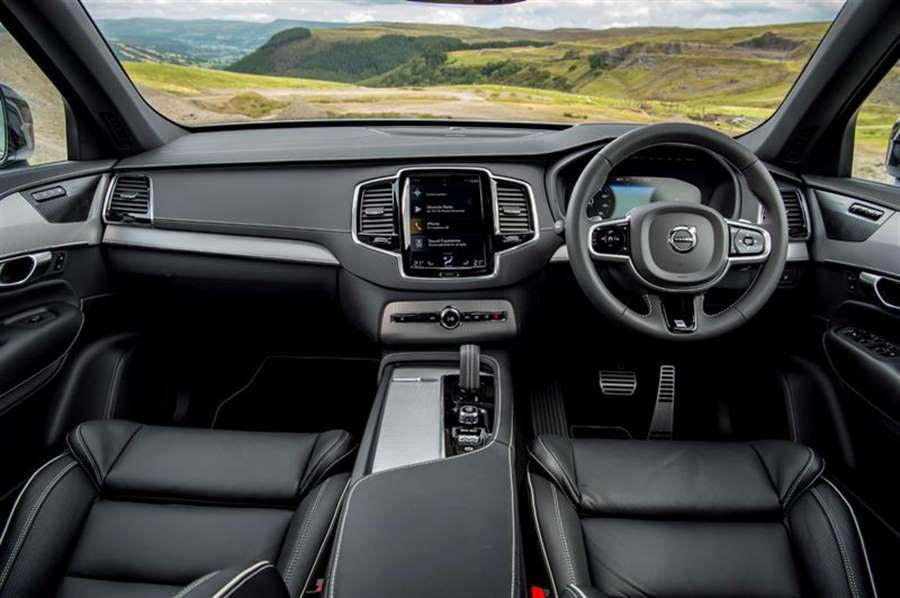
The best hybrid SUVs - on CAR
The XC90 T8 hybrid, or Recharge for short, is the most expensive, cleanest, frugalist, and quickest car of the XC90 range. Its raison d'etre is that it's a seven-seat plug-in hybrid - something of a rarity still.
It's aimed at the middle classes who can't quite commit to a fully-electric car, but still want the tax breaks and street cred associated with one.
While there's also a hint of the Q-car about it. Lovers of stealthy performance cars will be salivating at the thought of a 2.3-tonne family-hauler cracking the 0-62mph sprint in less than six seconds.
A 400bhp, £60k Volvo hybrid with a crystal gear selector
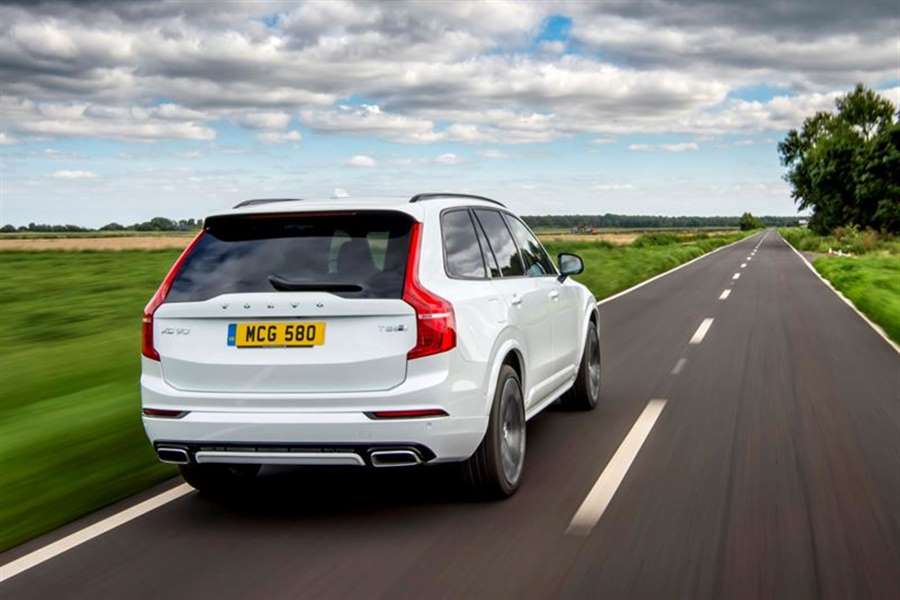
Expensive, fast, stylish and beautifully crafted, it’s a standard-bearer for the Swedish marque in its assault on the premium establishment, a move that’s being met with more success than Volvo dared hope.
The XC90 uses Volvo’s SPA scalable product architecture. It also underpins the S90 saloon and V90 estate, while the chassis was designed from the outset to package electric powertrains. In the T8 a petrol engine in the nose drives the front wheels via an eight-speed auto gearbox. A generator sandwiched between the two rapidly cranks the petrol engine into life, boosts torque and charges the battery as required.
The cells, housed in the central tunnel a propshaft normally calls home, feed a large single electric motor on the rear axle that also generates electricity under braking. A control unit in the engine bay synchronises the two power sources, ensuring happy, efficient collaboration and all-wheel drive when required.
Does the XC90 Recharge feel 400bhp fast?
Not quite – think effortless performance rather than unlikely dragster. Mash the throttle to the carpet in Power mode and the T8 launches pretty smartly, the battery pouring power into the electric motor as the turbocharged and supercharged direct-injection 2.0-litre four slogs its guts out. As a performance powertrain it’s undoubtedly effective, the claimed 5.8sec 0-62mph feeling entirely believable, but the car’s not inconsequential weight (2343kg) blunts performance.
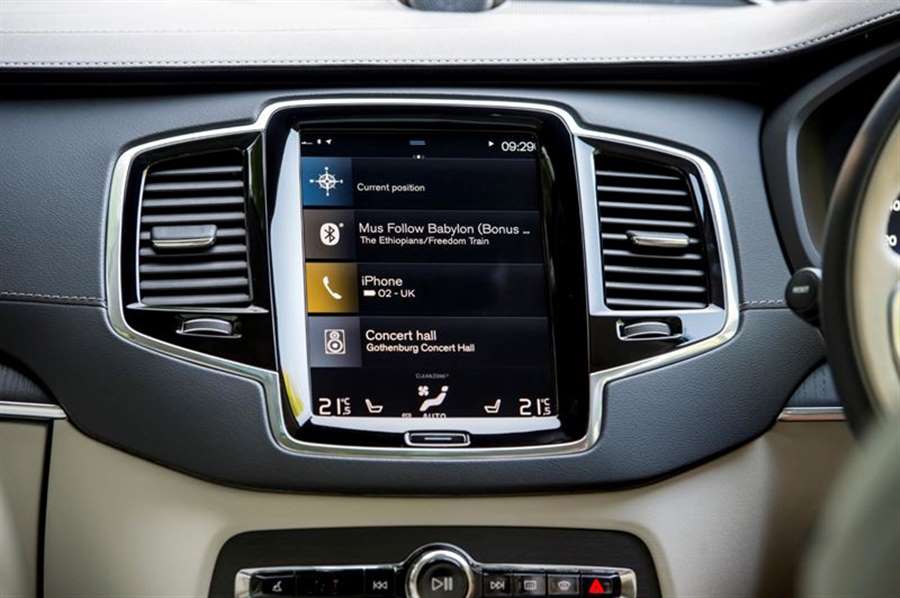
This kind of heavy-footed tomfoolery also feels pretty inappropriate, not because the chassis can’t cope – far from it – but because the petrol engine’s strains lack charm, shattering the XC90’s otherwise very endearing serenity. Volvo insists a more sonorous higher cylinder count would have been incompatible both with the firm’s product architecture and the wants of environmentally responsible consumers. Certainly the four-cylinder engine contributes much to the T8’s headline figures of 63-76g/km of CO2 and 83.1-100.9mpg on the combined cycle, though, after running one for six months, we can safely say the latter is an almost impossible figure.
The obscene three-figure MPG rating is synonymous with the plug-in hybrid car. We reckon if you charged religiously, and never drove more than 100 or so miles, the figure might be someway achievable. But the real hindrance to the XC90 is that when the battery is bereft of charge, you're realistically looking at a sub 30mpg car.
Volvo quotes an official electric range of 31 miles, but with day-to-day mixed driving expect more like 20.
Back to the drive modes. It's better to select the Hybrid and trade a little of Power’s throttle response and poke for improved economy and some far more agreeable peace and quiet. Either way the integration of electric and petrol power is almost seamless. At smaller throttle openings the petrol engine chiming in and out is almost undetectable, and the brake pedal is similarly well resolved, passing through the regenerative phase and into hydraulic braking with no discernible shift in resistance.
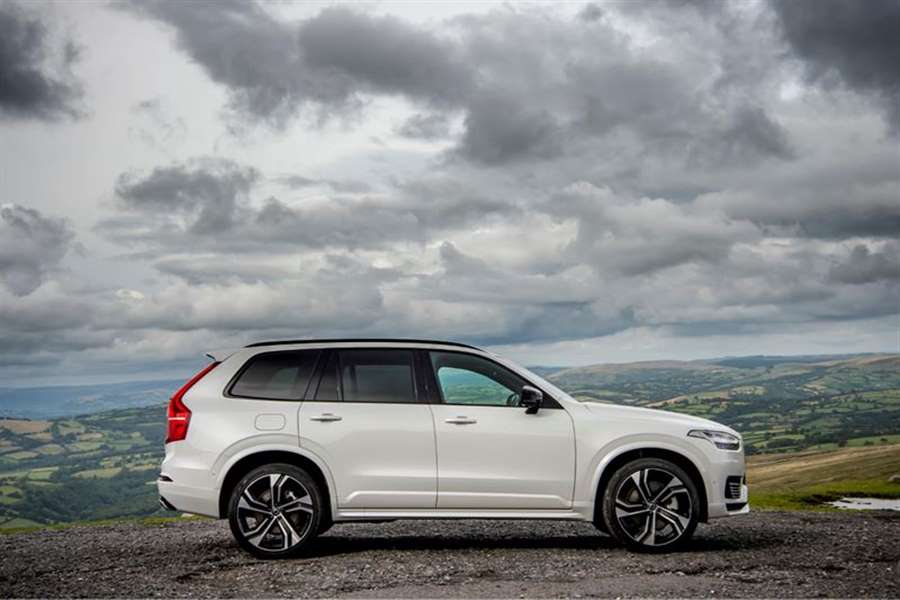
The usual PHEV functionality ensures a good degree of control: choose Pure mode to use only electric, select Braking on the gear selector for stronger regenerative braking on downhill runs, or even a lower gear for increased engine braking; use the instrument display or the dead-spot in the throttle pedal’s travel to stay on electric power, rather than accidentally triggering the petrol engine’s assistance.
High-rise limo or lively steer?
Air-suspended XC90s deliver an impressive drive, blending a cosseting ride with impressive body control. Appropriately there’s a little initial roll before the outer air struts take up the slack, lending the 5m-long seven-seater the wieldy feel of something much smaller and lighter.
Conventionally sprung XC90s manage a good impression of the same body control but lose a good deal of the ride quality, occasionally running out of answers on the kind of weather-beaten roads the UK does so well. So budget for the air suspension, which also drops the rear of the car by 50mm on demand for the easy loading of heavy furniture and arthritic dogs.
Back to that crystal gear selector
Curious timbers, machined aluminium and acres of beige leather don’t sound too promising but, almost irrespective of colour choice, the XC90’s is one of the finest interiors out there, certainly in anything like a comparable price bracket.
Fit and finish are exemplary, the design striking in a very pleasing, understated way and the overall sense of light, space and uncluttered calm the perfect ally to the T8’s potential for 31 miles of near-silent pure electric transportation. Additional NVH work has banished much of the background chatter of fans and compressors a combustion engine’s machinations normally mask, leaving an impressive and luxurious absence of noise.
Although the heating/cooling functions are controlled via the car's touchscreen. Which is annoying and fiddly on the move. Turning the heated seats on to their full power requires three stabs at the screen, for instance. And we can't help but the crystal gear selector is a bit...much.
Verdict
The XC90 is fundamentally a very fine SUV, and the hybrid powertrain has much to recommend it, not least the tax breaks afforded by its miserly CO2 output. While obviously 400bhp means it shifts like a V8.
However, for most people a diesel-engined XC90 delivers comparable if not superior economy, particularly if the battery’s never charged from the grid (50% of its existing PHEV owners don’t, according to Volvo) but the T8’s potential for both lunging bouts of acceleration and silent electric running is hugely attractive. Much like the car itself.
Since being launched, other manufacturers have caught up by offering plug-in hybrid SUVs. Audi, Range Rover, and BMW all have these in their arsenal - and all are newer too. Yet, the XC90 still delivers in being devastatingly fast and handsome, and nowhere near as audacious and flashy as them.
Source: carmagazine.co.uk
-
Volvo XC90 Recharge mixture survey
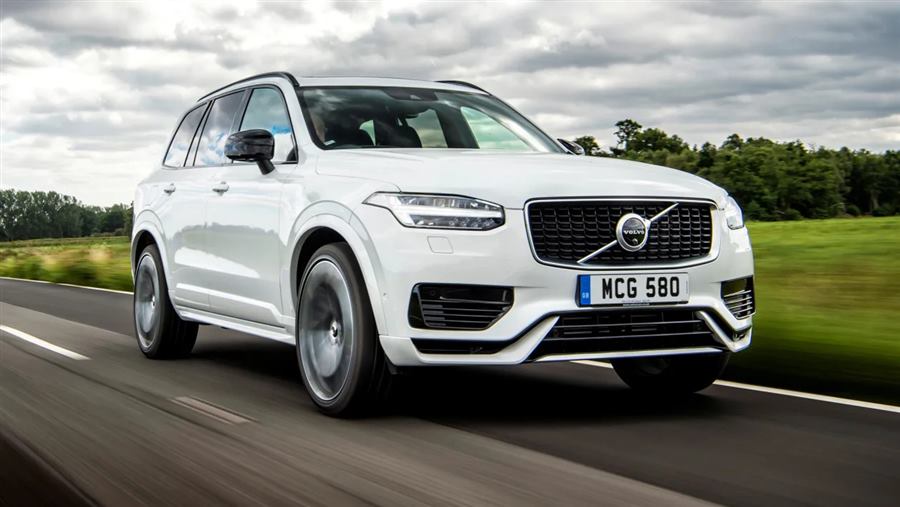
"The Volvo XC90 Recharge is beautiful, lavish and alluring yet it's not the most prudent enormous half and half SUV"
An opponent for the Mercedes GLE half and half, Audi Q7 TFSI e, BMW X5 xDrive45e and other huge extravagance mixture SUVs, the Volvo XC90 Recharge is a petroleum electric cross breed that plans to consolidate the reasonableness and solace of the remainder of the reach with great execution and further developed mileage.
The Recharge sits at the highest point of the XC90 territory, so while it's absolutely not modest, it is seething with hardware and highlights. Its inside is a fabulous spot to be, perfectly planned and loaded with innovation - the vast majority of which is controlled or observed by a halfway mounted picture infotainment screen that acts rather like a tablet. It's vaporous inside and the cowhide managed seats are among the most agreeable fitted in any vehicle for long excursions.
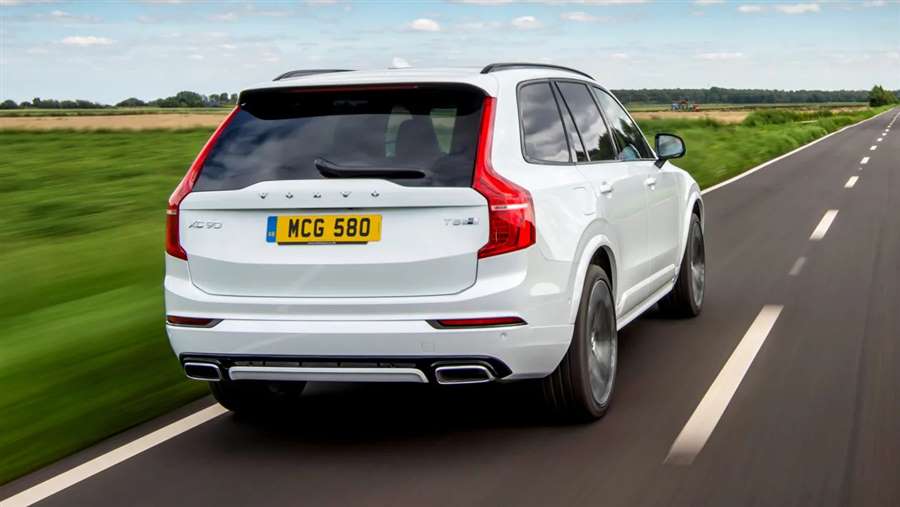
Power comes from a 2.0-liter petroleum motor in addition to an electric engine, which join to deliver 448bhp. It's exceptionally quick for this sort of vehicle, however the XC90 Recharge isn't a games SUV - the BMW X5 xDrive45e, for instance, handles better on more tight streets. Consider rather the XC90 Recharge as a strong and truly agreeable vehicle for regular driving, and the Volvo takes some beating.
Regardless of having seven seats and a crossover powertrain, the Volvo XC90 Recharge is still extremely reasonable. The batteries just diminish boot space by 40 liters and even with each of the seven seats up, you've actually got a boot that is a comparative size to a supermini's. Grown-ups will be very cheerful in the rearmost seats, albeit a Land Rover Discovery will be considerably more agreeable in the event that you're routinely conveying heaps of individuals.
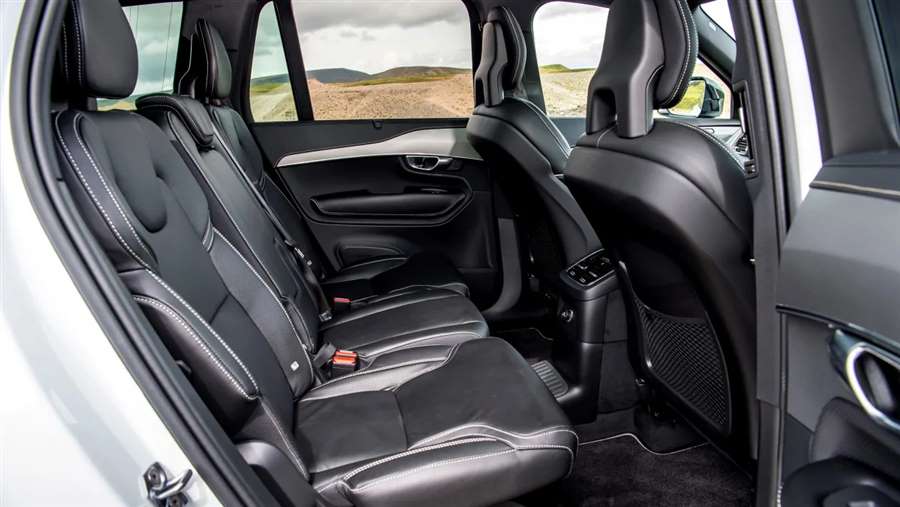
MPG, running expenses and CO2
With the Recharge's authoritatively cited economy figure of 83.1 to 217mpg, you'd be excused for thinking it was one of the most economical half and halves around, yet unfortunately this isn't true during genuine driving. To accomplish anything near this figure, you'll need to drive without taking advantage of the vehicle's incredible presentation, stick to metropolitan streets and ensure its batteries are completely energized, as well. Its electric-just scope of somewhere in the range of 27 and 43 miles (contingent upon the haggles fitted) is cutthroat with most opponents, yet the BMW X5 xDrive45e is in front of the Volvo with its 50-mile range, because of a 24kWh battery, while the Mercedes GLE 350 de has a much bigger 30.8kWh battery and 66-mile range. The XC90 Recharge has a 14.9kWh lithium-particle battery.
As it's a half and half with CO2 discharges of 28-76g/km, the XC90 Recharge has a low first-year charge bill (normally moved into the out and about cost). After this, you'll pay the option fuel vehicle VED rate each year, in addition to an extra charge from years two to six, because of the Recharge's £40,000-in addition to asking cost. Because of its low outflows, the mixture XC90 has a low Benefit-in-Kind (BiK) organization vehicle charge rating, yet it's at this point not excluded from the London Congestion Charge, which currently just applies to zero discharges models.
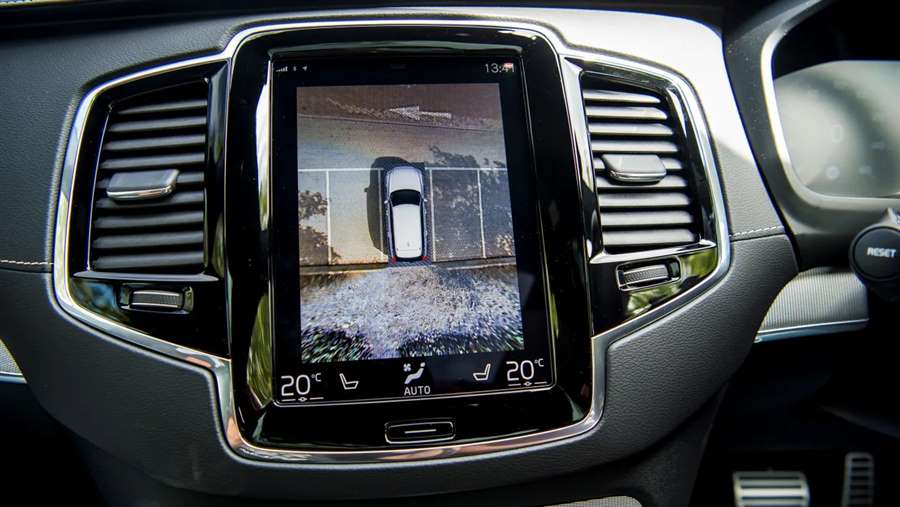
Similarly as with all Volvos, the module XC90 accompanies a guarantee that goes on for a considerable length of time or 60,000 miles, whichever starts things out. Because of the presentation on offer, the Recharge is among the most costly XC90 to safeguard; it sits in bunches 44-45 (out of 50) contingent upon trim level.
Motors, drive and execution
With 448bhp from its joined petroleum motor and electric engine, the XC90 Recharge is the quickest vehicle in the reach. It can reach 62mph from a stop in 5.4 seconds, while its maximum velocity is electronically restricted to 112mph. There's loads of force down and out the fire up reach and it is great to overwhelm execution. It's a second quicker to 62mph than the eco-disapproved of Mercedes GLE 350 de, yet has an emphasis on solace so it's not the most ideal SUV for twisty streets. It's quite far off offering the lively allure of the BMW X5 xDrive45e, as well. The Volvo is best at loose, steady, rapid cruising; it's a major, weighty vehicle that becomes disrupted assuming you're too forceful in the corners.
The XC90 Recharge is as yet a delight to drive, in any case. Its controlling is light and there's bunches of grasp and foothold on account of its four-wheel-drive framework, making it more fulfilling than the delicate Lexus RX L 450h. Like most XC90s, the Recharge is most at home on more extensive, open streets, however by and large's not difficult to drive generally speaking gave its size isn't an issue. On the off chance that you're utilized to a more modest vehicle, you could require an opportunity to conform to the Recharge's significant length, width and weight.
Inside and solace
Moderate yet sumptuous - the Volvo XC90 has one of the most outstanding insides around
Perhaps of the greatest benefit the Volvo XC90 Recharge has over its adversaries is its awesome inside. It's gigantically agreeable paying little mind to where you're sitting, with lashings of cowhide and quality trim causing it to feel unmistakably upmarket. It's planned in a pleasingly unfussy way, as well.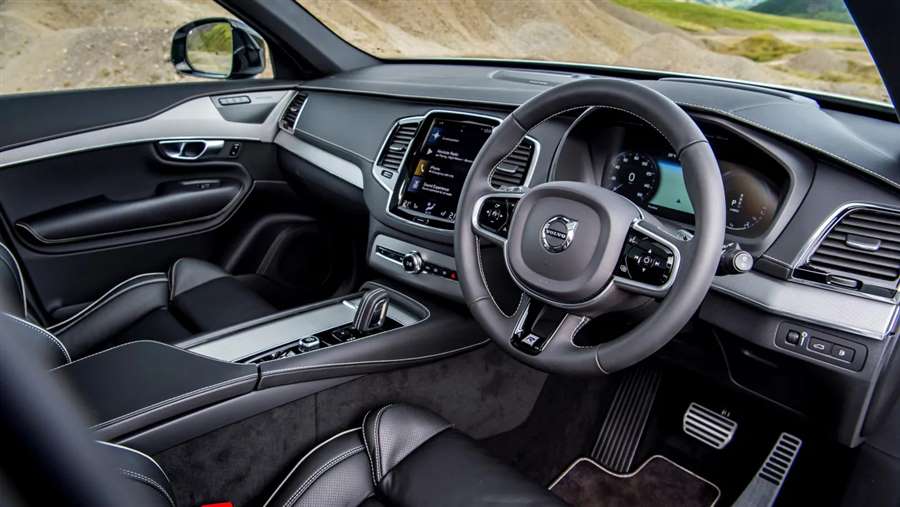
The dashboard is overwhelmed by a focal touchscreen that controls everything from the multi-zone environment control to the sat nav, sound system and different settings. On the off chance that you're mechanically disapproved, you'll adore the tablet-like connection point - however if not, it could require an investment to become accustomed to. Joined by another screen replaces customary dials behind the directing wheel. This is not difficult to peruse and can show every kind of data, including sat-nav bearings. Touch radio, and Android Auto network and an incredible 10-speaker sound system come as standard. Google-based programming additionally implies it feels immediately natural to cell phone clients.
Given you don't work the motor too hard, it's surprisingly calm in the XC90 Recharge's inside, which when joined with the agreeable and broadly customizable seats, 'CleanZone' air quality control framework and a delicate, controlled ride, makes it an exceptionally great vehicle to go in. With the air suspension (standard on the Ultimate models), things just get more wonderful.
Standard hardware is phenomenal on the Recharge, paying little heed to which trim level you pick. The cross breed can be had in Core, Plus and rich Ultimate trims, alongside Dark and Light renditions for a really brandishing or customary outside plan with sparkle dark or chrome trim separately. Indeed, even the least expensive is genuinely rich, with 19-inch combinations, full LED headlights, front and back stopping sensors and a switching camera, a fueled rear end and full cowhide trim, among other engaging elements.
Furthermore profits by an opening all encompassing sunroof, versatile headlights, a 360-degree camera, surrounding inside lighting and a Harman Kardon speaker update. Extreme adds 21-inch composites and versatile air suspension, alongside fleece mix upholstery, a head-up show and a significantly more impressive Bowers and Wilkins sound system with 18 speakers for a really vivid encompass sound insight.
Reasonableness and boot space
A lot of room for seven individuals and an enormous boot that is effectively made much greater
As perhaps of the biggest vehicle out and about, it's not shocking that the Recharge is likewise exceptionally extensive inside. With each of the seven seats being used, there's 262 liters of room in the boot - extraordinary for a vehicle of this sort. Notwithstanding, crease them generally down and you're left with a colossal, van-like 1,816 liters to the rooftop. With all seats in the second and third lines collapsing exclusively, Volvo claims the seats can be arranged in 32 distinct ways. The XC90 is a lot greater and more flexible than the five-seat BMW X5 xDrive45e; just the electric Tesla Model X can match it in the class - it beats the Volvo's complete seats-collapsed space, yet its third line isn't exactly as obliging.Leg and headroom are fantastic in every one of the three lines and third-column travelers shouldn't experience a lot of difficulty getting into their seats thanks to huge entryways and sliding center column seats. There are a lot of cubbies dispersed all through the lodge, with even third-column travelers getting their own stockpiling canisters.
Assuming you intend to tow with your XC90 Recharge, it's essential to take note of that its most extreme braked-trailer towing weight is 2,400kg. This is 300kg under XC90s with the most impressive motors, so in the event that you anticipate towing a huge train, horsebox or boat trailer, you could require the petroleum or diesel model. The Recharge's towing limit is still nice, particularly as numerous crossovers can tow a negligible portion of that weight.
Dependability and wellbeing
Class-driving evaluations and loads of astute wellbeing innovation
The freshest Volvo XC90 didn't highlight in our Driver Power 2021 review however the more modest Volvo XC40 came eighth out of the main 75 vehicles marked down. Volvo itself completed 10th out of 30 producers. Proprietors commended motors and gearboxes, as well as solace and in-vehicle amusement, and the brand performed well for security. All of this looks good for the reach besting crossover XC90.Volvo is celebrated for its wellbeing and the XC90 is no exemption, procuring a five-star Euro NCAP crash-test score and incredible 97 and 87% evaluations for grown-up and youngster security individually. The XC90 likewise has bunches of smart innovation fitted as standard to assist with staying away from crashes, including IntelliSafe, a framework that cautions of perils ahead and brakes for you if necessary - basically a high level AEB (programmed crisis stopping mechanism.
The vehicle additionally includes a high level vulnerable side checking framework that can control once again into path assuming you're going to crash into another vehicle, and will try and brake and steer itself assuming it detects you've left the street. These, in addition to a lot of other standard frameworks, cause the XC90 To re-energize one of the most secure SUVs around - crossover etc.

